The birds of Mexico are an incredible collection of species, ranging from tropical parrots to hummingbirds to eagles. With over 1,100 species, Mexico is home to some of the most diverse and interesting birds in the world.
From the tiny, colorful hummingbirds of the Yucatan to the majestic golden eagles of the Sierra Madres, Mexico’s avian population is a sight to behold. From their unique calls to their colorful plumage, Mexico’s birds are a delight to any bird watcher, providing a glimpse into the vastness and beauty of this unique country.
1. Great-Tailed Grackle
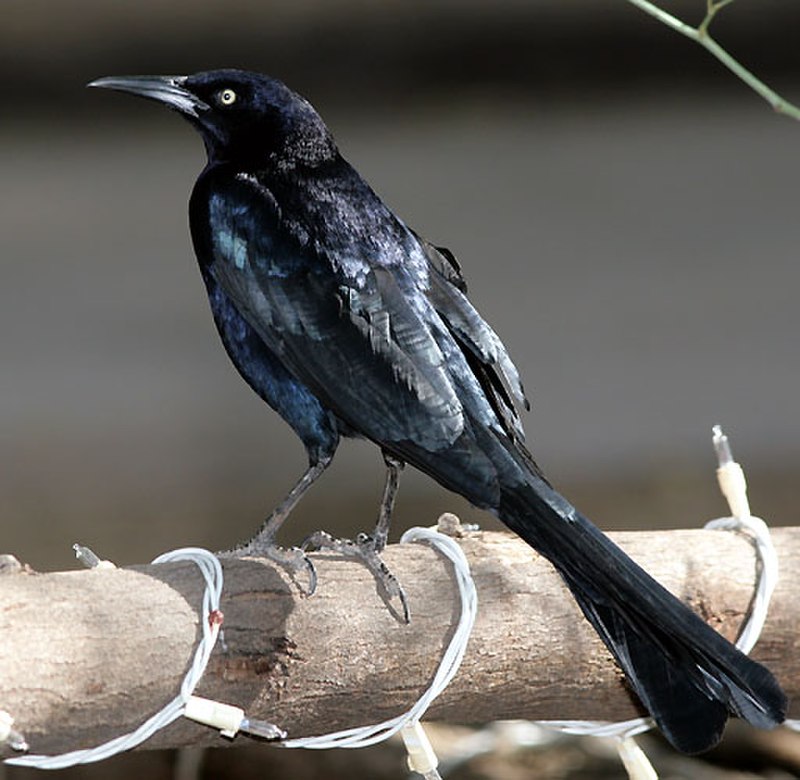
The Great-tailed Grackle is a medium sized bird native to North and South America. It belongs to the family Icteridae, making it closely related to two other species of grackles – the Boat-tailed and Slender-billed.
They are highly social birds which often appear in large flocks or colonies.
Their plumage ranges from glossy black with blue or purple iridescence, through brownish grey shades depending on location.
In some areas they have been known as “blackbirds” due their predominately dark colouring.
This adaptable species is also renowned for its distinctive long tail feathers – hence its name.
Scientific classification:
| Kingdom | Animalia |
| Phylum | Chordata |
| Class | Aves |
| Order | Passeriformes |
| Family | Icteridae |
| Genus | Quiscalus |
| Species | Q. mexicanus |
Also Featured In: Common Birds That Live in Las Vegas, Common San Antonio Birds
2. Rock Dove
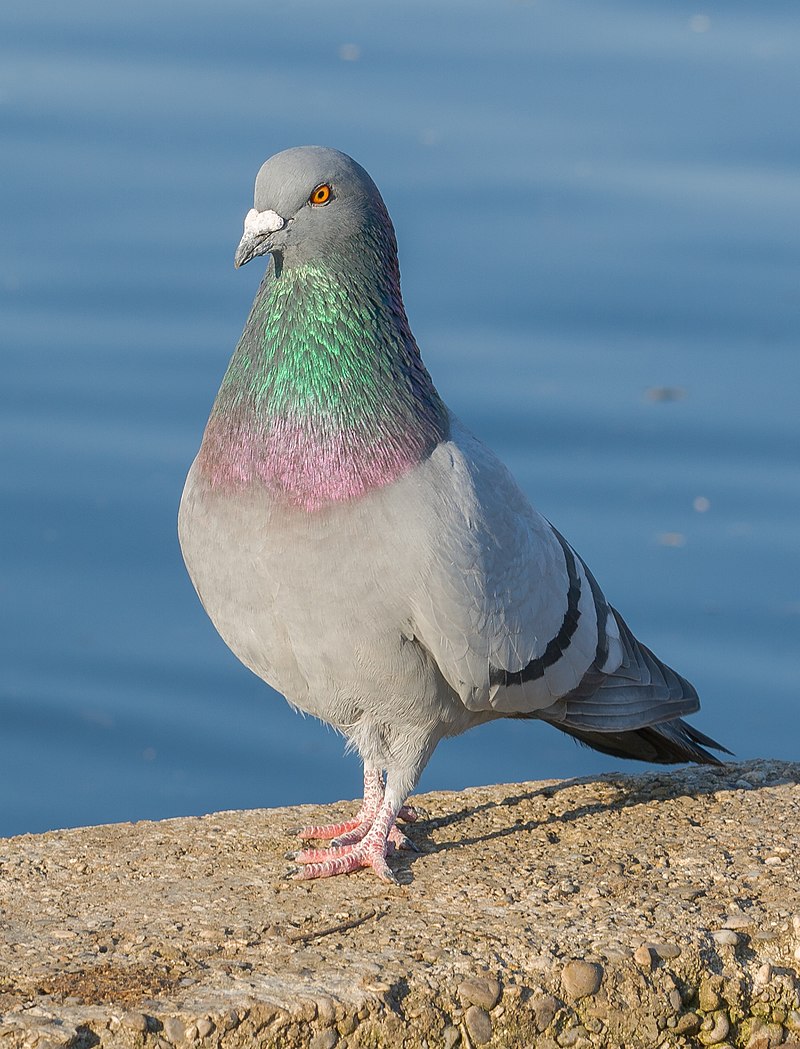
Rock dove, also known as Rock Pigeon or Common Pigeon, is a member of the bird family Columbidae.
It is considered to be an important creature worldwide due to its domestication by humans centuries ago; resulting in the modern-day Domestic pigeon which descends from this species.
Its population has increased over time because some domestic pigeons have escaped captivity and joined wild populations.
The rock dove can most easily be identified by its prominent blue-grey feathers with darker bars on wings and tail along with two black bands on each wing.
They are typically found in large flocks near cliffs or buildings but may also inhabit rural habitats such as open fields and meadows if there’s enough food available for them nearby.
Although they don’t migrate far distances like other birds, their numbers increase significantly during winter months.
When more food sources become available closeby so that they won’t need to travel too far away from home base for nourishment.
Scientific classification:
| Kingdom | Animalia |
| Phylum | Chordata |
| Class | Aves |
| Order | Columbiformes |
| Family | Columbidae |
| Genus | Columba |
| Species | C. livia |
3. White-Winged Dove
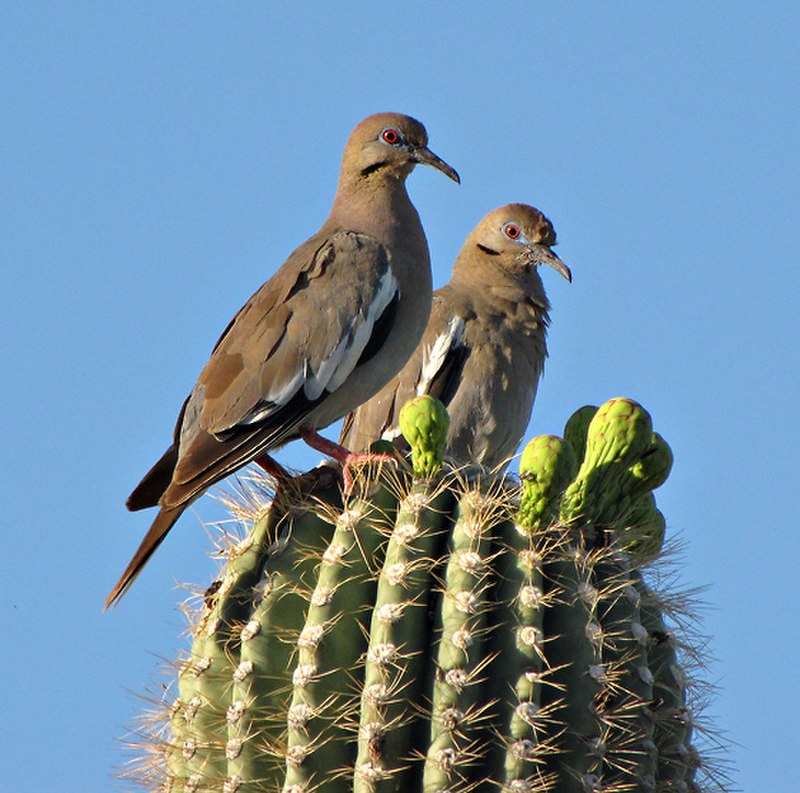
The White-winged Dove is an impressive bird with a large body and wingspan. Its distinctive feature is the white edge on its wings, which makes it easily recognizable when in flight.
It has blue eyerings, red eyes and gray plumage, while juveniles are duller in coloration than adults.
This dove species inhabits areas from Southwestern United States through Mexico to Central America as well as Caribbean islands.
They usually live close to human settlements or cities but can also be found in agricultural fields feeding on grains like corn or wheat seeds left by farmers after harvest season ends.
In their natural habitat they feed primarily on insects, fruits and small plants such as certain cacti species.
Scientific classification:
| Kingdom | Animalia |
| Phylum | Chordata |
| Class | Aves |
| Order | Columbiformes |
| Family | Columbidae |
| Genus | Zenaida |
| Species | Z. asiatica |
Also Featured In: Phoenix Birds You Should Know, Birds that Live in the Deserts
4. Golden-Cheeked Woodpecker
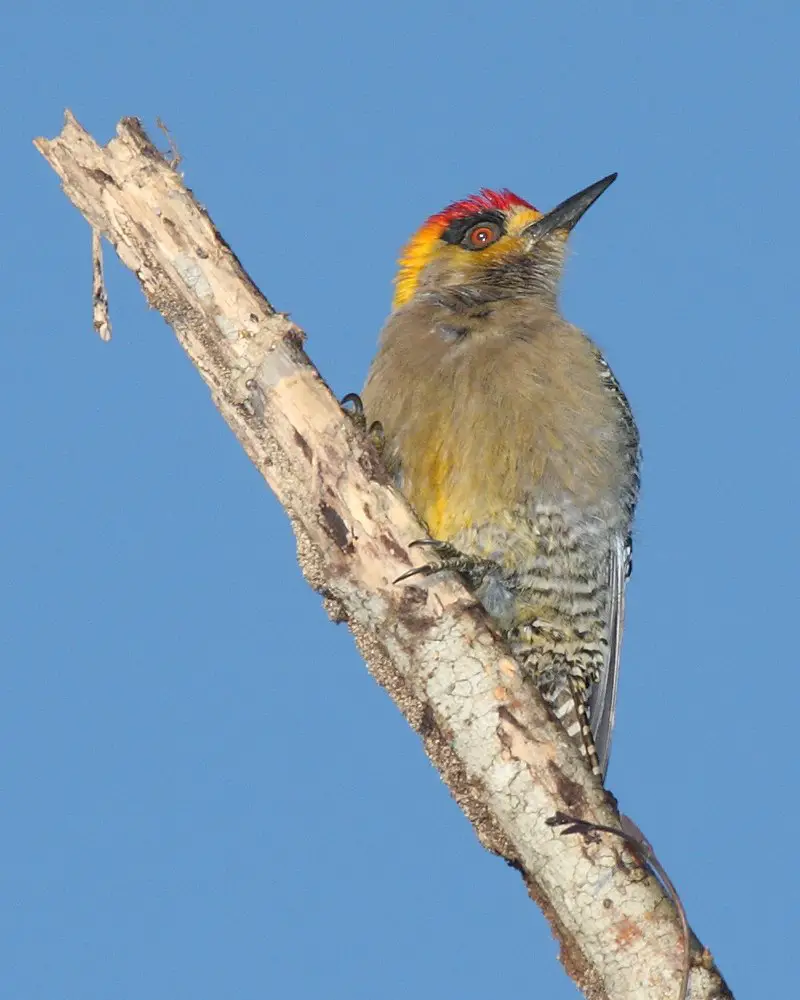
The Golden-cheeked Woodpecker is a unique species of bird found in Mexico. This beautiful creature has golden cheeks and chestnut plumage, with the male sporting a bright red crown on its head.
Endemic to the Pacific coastal strip from Sinaloa to Colima, it can also be seen inhabiting areas along the western mountain slopes of Trans-Mexican Volcanic Belt.
It prefers subtropical or tropical dry forests as their natural habitat where they search for food such as insects and larvae that are hidden deep inside tree trunks and branches.
The Golden-cheeked Woodpecker is an important part of Mexican wildlife which needs protection if we want this species to survive for future generations.
Scientific classification:
| Kingdom | Animalia |
| Phylum | Chordata |
| Class | Aves |
| Order | Piciformes |
| Family | Picidae |
| Genus | Melanerpes |
| Species | M. chrysogenys |
Also Featured In: Puerto Vallarta Birds You Should Know, Most Common Birds Found in Nayarit
5. American Robin

The American robin is a migratory bird, belonging to the true thrush genus and Turdidae family.
It was named after its European counterpart due to the similar reddish-orange breast they both possess; however, they are not related closely.
This species can be seen through most of North America during winter months, as well as in parts of Mexico and Central America where it also breeds.
They have plump bodies with gray upperparts and white underparts that vary from yellow on their throats down to orange toward their bellies.
Robins feed on fruits such as berries or insects like worms which makes them an important part of ecosystems by helping disperse seeds naturally throughout these areas.
Scientific classification:
| Kingdom | Animalia |
| Phylum | Chordata |
| Class | Aves |
| Order | Passeriformes |
| Family | Turdidae |
| Genus | Turdus |
| Species | T. migratorius |
6. Inca Dove
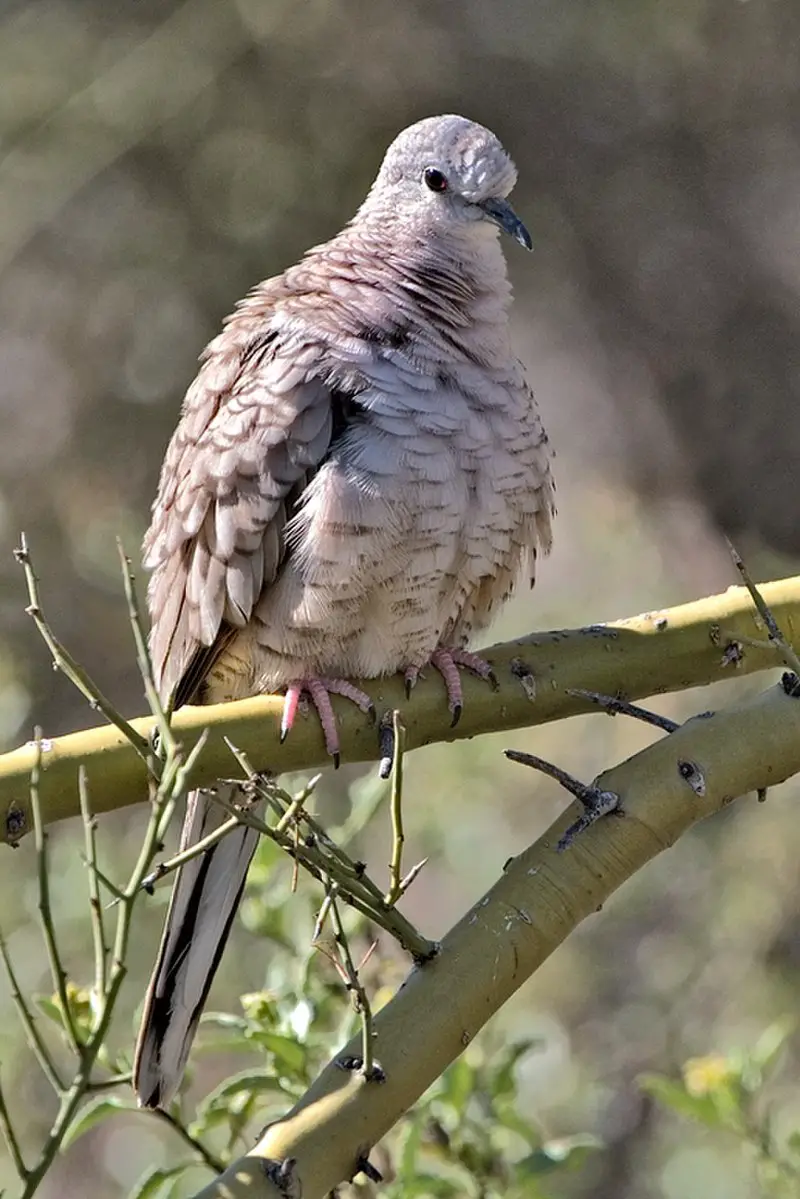
The Inca Dove is a small, slender bird found in the New World. It has an average length of 16.5–23 cm and weighs about 30-58 gm. Its wingspan measures around 28.5cm but can reach up to 32cm at max.
The body of this dove is grayish brown with feathers that are rounded off tips giving it a soft look overall.
This species was first described by French surgeon and naturalist René Lesson back in 1847 and since then have been living happily all over North America from Mexico through Texas to South Dakota, Kansas as well as parts of Arizona among others regions too.
Scientific classification:
| Kingdom | Animalia |
| Phylum | Chordata |
| Class | Aves |
| Order | Columbiformes |
| Family | Columbidae |
| Genus | Columbina |
| Species | C. inca |
Also Featured In: Birds You’ll Find in South Texas , Birds You’ll Find in the Rio Grande Valley
7. Mourning Dove
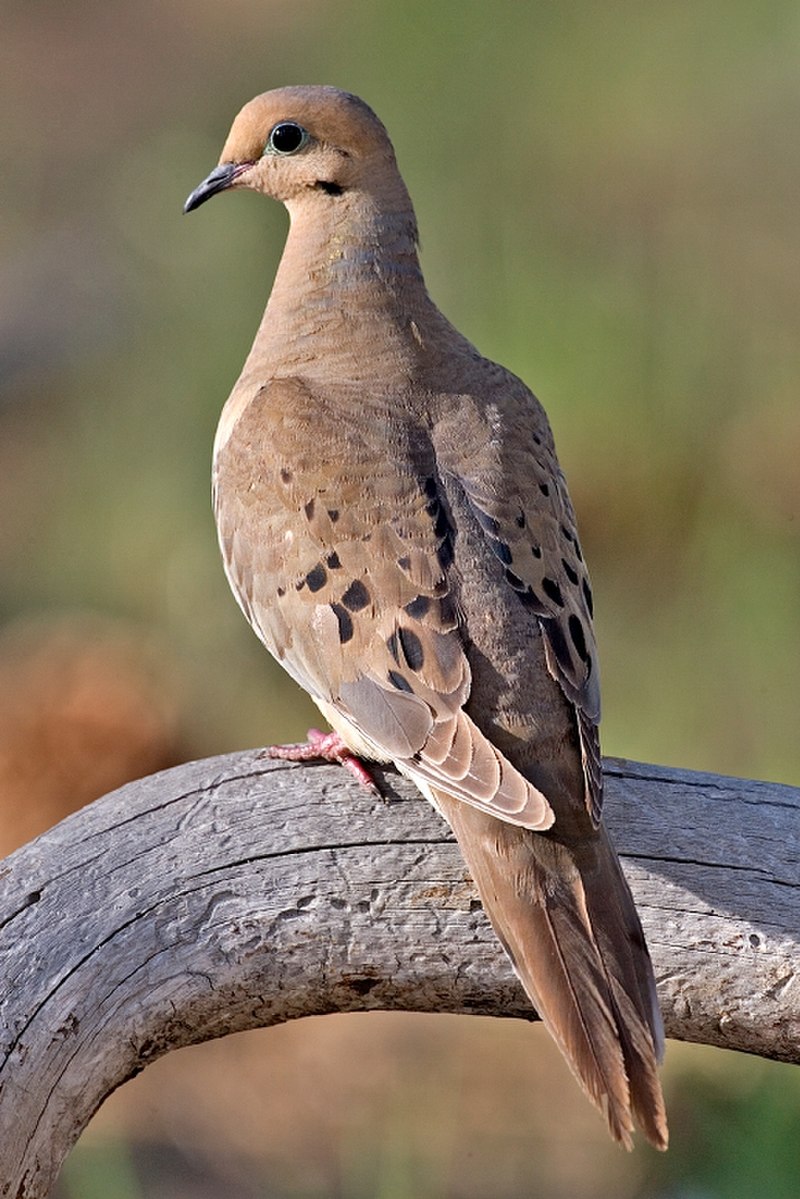
The Mourning Dove is a breathtakingly beautiful bird. It has stunning gray and brown feathers with white tipped wings, giving it an elegant appearance. Its long tail also adds to its graceful look in flight.
A symbol of peace and serenity, they are abundant across North America and can be found in gardens or open fields throughout the year.
As well as being popular game birds for hunters, they feed on grains such as wheat and millet providing important food sources for wildlife species including foxes, coyotes, skunks and raccoons.
These doves have a distinctive cooing sound that can often be heard echoing through woodlands during summer evenings making them one of nature’s greatest treasures.
Scientific classification:
| Kingdom | Animalia |
| Phylum | Chordata |
| Class | Aves |
| Order | Columbiformes |
| Family | Columbidae |
| Genus | Zenaida |
| Species | Z. macroura |
8. West Mexican Chachalaca
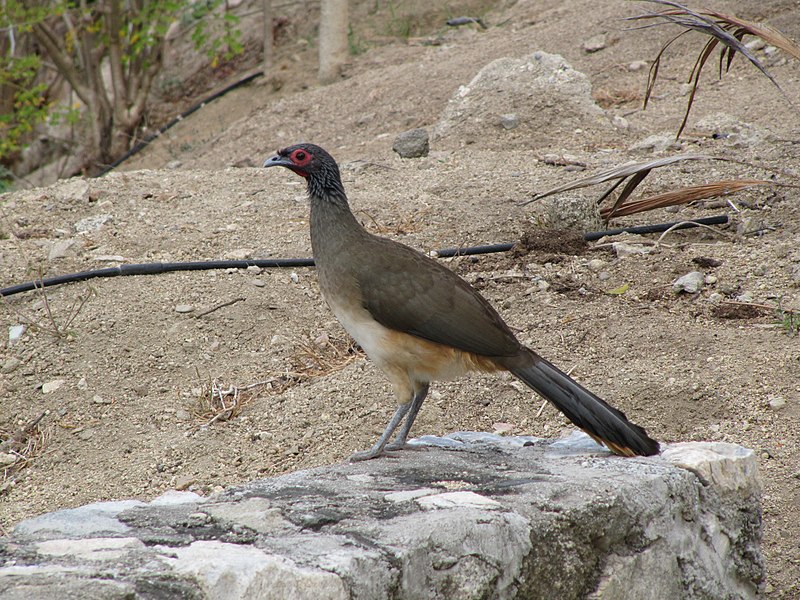
The West Mexican chachalaca is a species of bird from the family Cracidae found in Mexico. It was initially described as Penelope poliocephala and later moved to genus Ortalis.
At one time, it was considered a subspecies of plain chachalaca (Ortalis vetula). The West Mexican Chachalaca has slate-grey plumage with blackish wings and tail feathers that are bordered above by white stripes.
Its head is adorned with an orange tufted crest, while its bill is yellow or greenish-yellow coloured on top and grey underneath.
This medium size bird feeds mainly on fruits and insects but also consumes flowers, leaves & bark occasionally.
They live in small flocks in forests near rivers or humid areas close to mountains ranging between 500m – 3000m elevation up northwards into the Sierra Madre Occidental region of northern Mexico where they can be seen foraging during early mornings before flying off singly at dusk back towards their roosting sites amongst trees inside dense woods.
Scientific classification:
| Kingdom | Animalia |
| Phylum | Chordata |
| Class | Aves |
| Order | Galliformes |
| Family | Cracidae |
| Genus | Ortalis |
| Species | O. poliocephala |
Also Featured In: Most Common Oaxaca Birds,
9. Rufous-Backed Robin
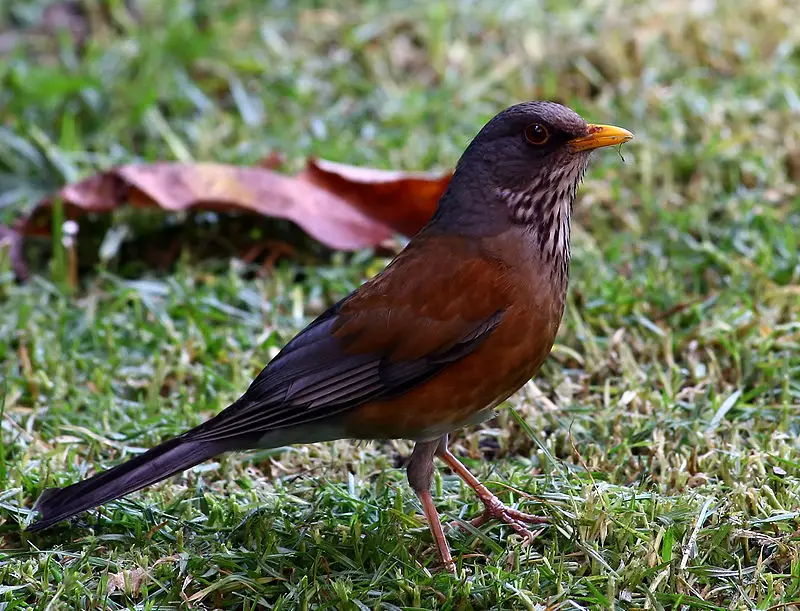
The Rufous-backed Robin, also known as the Rufous-backed Thrush, is a stocky songbird native to the Pacific slopes of Mexico.
With an average length of 21.5–24 cm (8.5–9.4 in) and weight 74 g (2.6 oz), it has similarities with its widespread relative – American robin – but is slightly smaller in size, having an average wingspan measuring 39.4 cm (15.5 in).
It possesses striking features such as yellow eyes bordered by black eye rings; white throat surrounded by a grey neck patch; buffish upperparts that are crossed with darker streaks or spots on both sides; and lastly rusty red tail feathers which gives this species its name.
Scientific classification:
| Kingdom | Animalia |
| Phylum | Chordata |
| Class | Aves |
| Order | Passeriformes |
| Family | Turdidae |
| Genus | Turdus |
| Species | T. rufopalliatus |
Also Featured In: Common Birds of Mexico City, Birds that Live in Morelos
10. Loggerhead Shrike
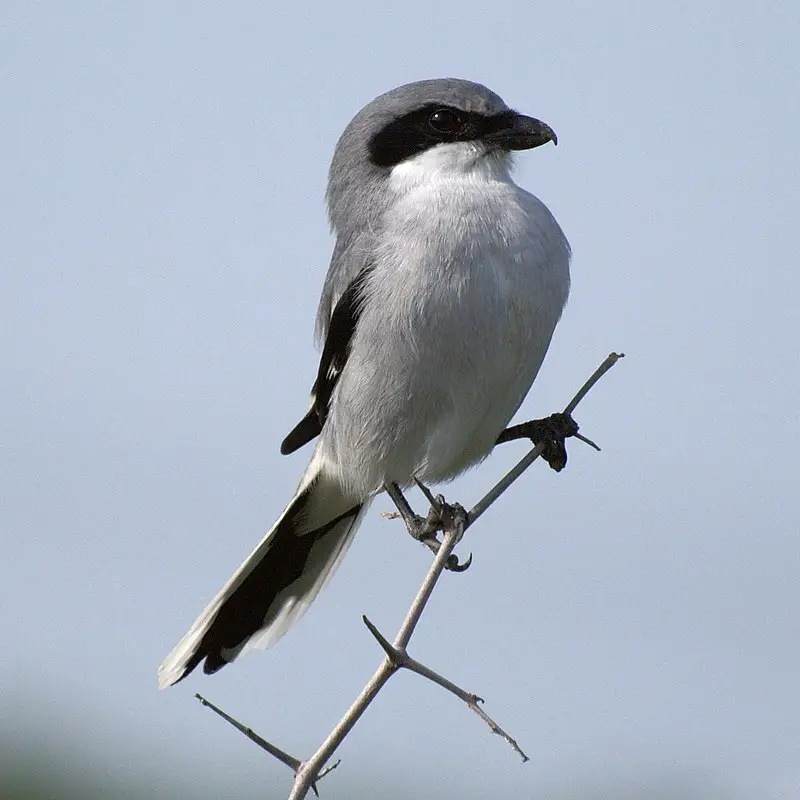
The Loggerhead Shrike is a carnivorous bird found only in North America. It belongs to the family Laniidae and is known as the “butcherbird” because of its habit of catching prey, such as amphibians, insects, lizards and small mammals.
The shrike has a black mask around its eyes and grey wings with white patches on them.
Its back is black with white spots that resemble stars or snowflakes; some individuals may have brown feathers instead of black ones.
This species feeds mainly by perching from elevated locations like bushes or trees where it can spot potential meals below it before diving down for capture.
Interestingly enough, these birds are also known to store their food by impaling it onto thorns which they use later when hungry.
With less than 2 million estimated population left in wild today this species needs our help so we should do whatever we can to protect them better.
Scientific classification:
| Kingdom | Animalia |
| Phylum | Chordata |
| Class | Aves |
| Order | Passeriformes |
| Family | Laniidae |
| Genus | Lanius |
| Species | L. ludovicianus |
Also Featured In: Birds Live in Arkansas, Common Birds in Alberta
11. Russet-Crowned Motmot
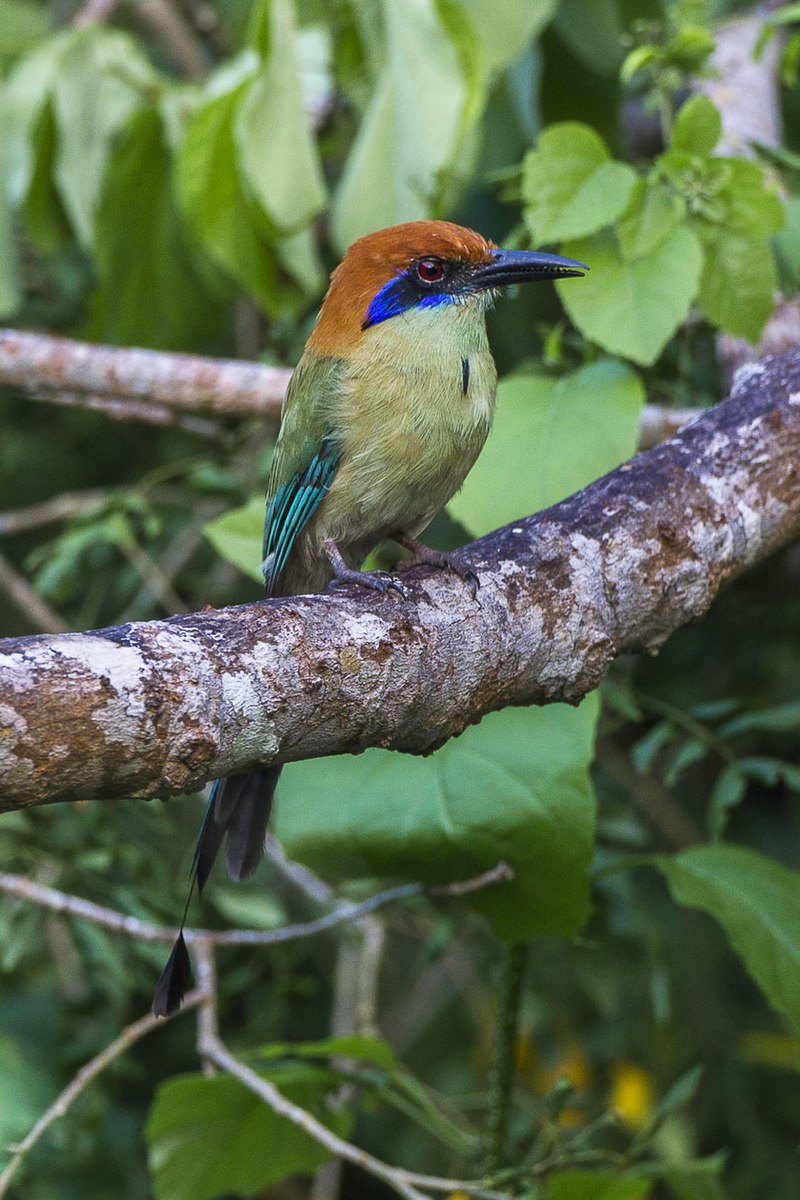
The Russet-crowned Motmot is an exotic species of bird native to north-western Mexico and central Guatemala. It is a year round resident in tropical dry broadleaf forests, scrubland and other areas with plentiful vegetation.
This type of motmots are easily identified by their reddish-brown crest on top of their heads which gives them the name ‘russet’ crowns.
These birds have also been observed displaying unique behaviors such as “bill-wagging” where they will move their bills from side to side while perched atop branches or trees.
They can be found eating insects, reptiles, amphibians, fruits and occasionally small mammals like mice or bats.
The russet crowned motmot population has declined due to deforestation but conservation efforts are helping protect this beautiful creature so that future generations may enjoy it’s majestic beauty for years to come.
Scientific classification:
| Kingdom | Animalia |
| Phylum | Chordata |
| Class | Aves |
| Order | Coraciiformes |
| Family | Momotidae |
| Genus | Momotus |
| Species | M. mexicanus |
Also Featured In: Birds that You’ll Find in Chiapas,
12. Bewick’s Wren
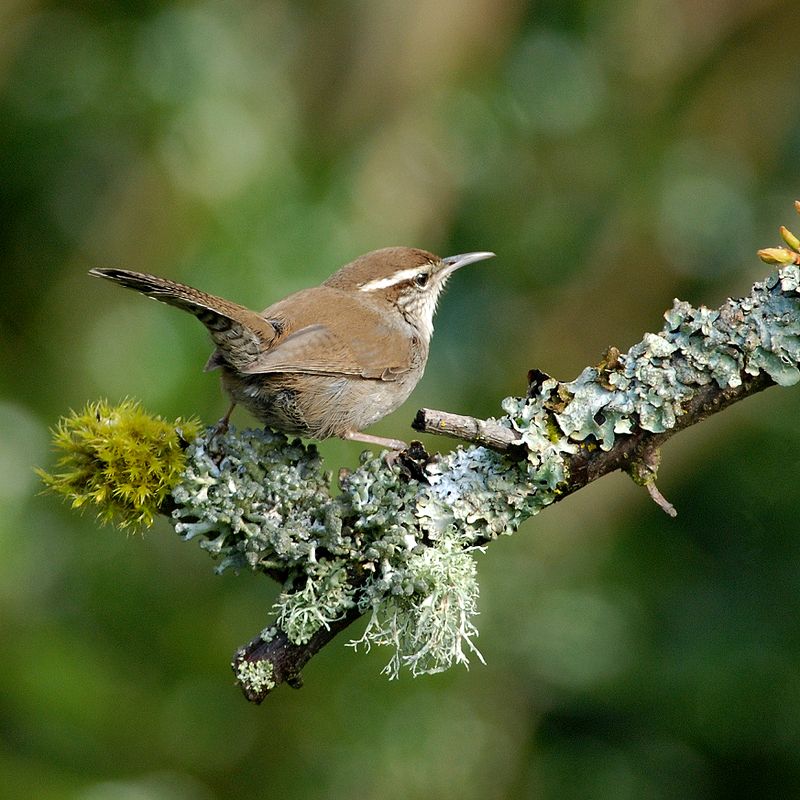
The Bewick’s wren (Thryomanes bewickii) is a small, grey-brown bird native to North America. Measuring at around 14 cm long it has distinctive white markings on its face and tail giving it an attractive appearance.
It can often be found in thickets or scrubby areas as well as urban gardens and parks.
Its song is loud and melodious which makes them popular amongst ornithologists; they are known for their complex vocalisations composed of whistles, clicks, churrs and trills.
The Bewick’s Wren mainly feeds on insects but will also eat fruits if available during the colder months when food may otherwise be scarce.
This species of wren plays an important role in controlling insect populations making them beneficial inhabitants of our environment.
Scientific classification:
| Kingdom | Animalia |
| Phylum | Chordata |
| Class | Aves |
| Order | Passeriformes |
| Family | Troglodytidae |
| Genus | Thryomanes P.L. Sclater, 1862 |
| Species | T. bewickii |
Also Featured In: Common Southern Californian Birds, Birds That Live around Seattle
13. Sanderling
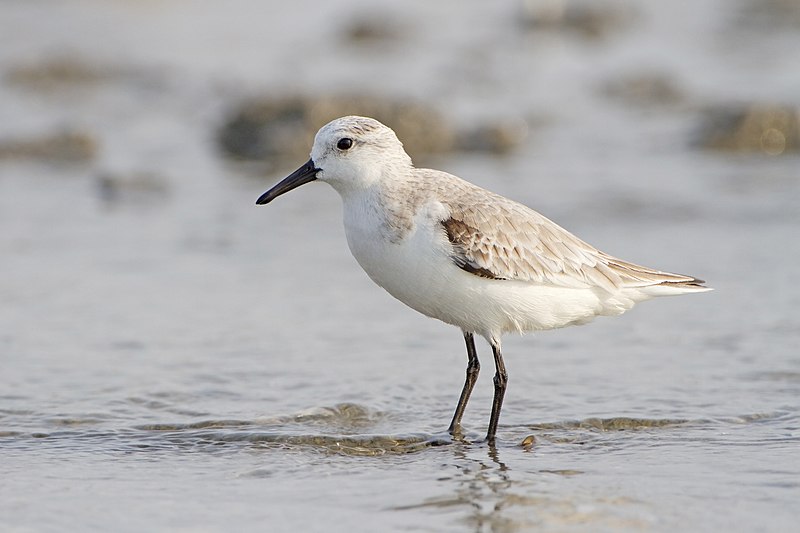
The Sanderling is a small wading bird that can be found in the Arctic region. Its name comes from Old English, meaning “sand-ploughman”. It has grey feathers and light legs which give it its distinct white coloration.
During summer breeding months, they are known to travel great distances – some wintering as far south as South America or Southern Africa. They typically feed on crustaceans such as shrimp and mollusks along coastal shores.
The Sanderling is an important species to watch out for because of their long migratory patterns and sensitivity to environmental change; if there’s trouble with this species then other birds may also be affected.
Scientific classification:
| Kingdom | Animalia |
| Phylum | Chordata |
| Class | Aves |
| Order | Charadriiformes |
| Family | Scolopacidae |
| Genus | Calidris |
| Species | C. alba |
Also Featured In: Birds You’ll Find in the Sea, Galapagos Birds You Should Know
14. Pied-Billed Grebe
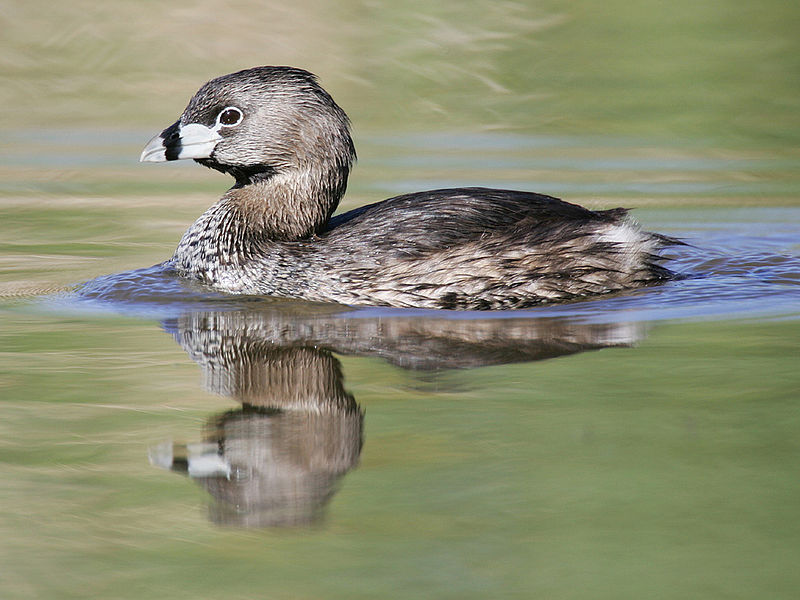
The Pied-billed Grebe is a water bird found in ponds throughout the Americas. It has earned many nicknames, including American dabchick, rail, and Carolina grebe.
This species of grebe can be recognized by its distinctive bill which is pied or mottled with black and white markings.
Its brownish body is also covered in dark spots as well as having long legs for swimming underwater to catch food such as aquatic insects and crustaceans.
The Pied-billed Grebes are monogamous birds that pair up during breeding season from spring to summer where they build their nests together on vegetation near the shoreline of lakes or slow moving rivers.
These birds are solitary outside of mating season but will form small flocks when migrating south for winter months.
Scientific classification:
| Kingdom | Animalia |
| Phylum | Chordata |
| Class | Aves |
| Order | Podicipediformes |
| Family | Podicipedidae |
| Genus | Podilymbus |
| Species | P. podiceps |
Also Featured In: Water Birds Live around Us, Common Central Park Birds
15. White-Faced Ibis
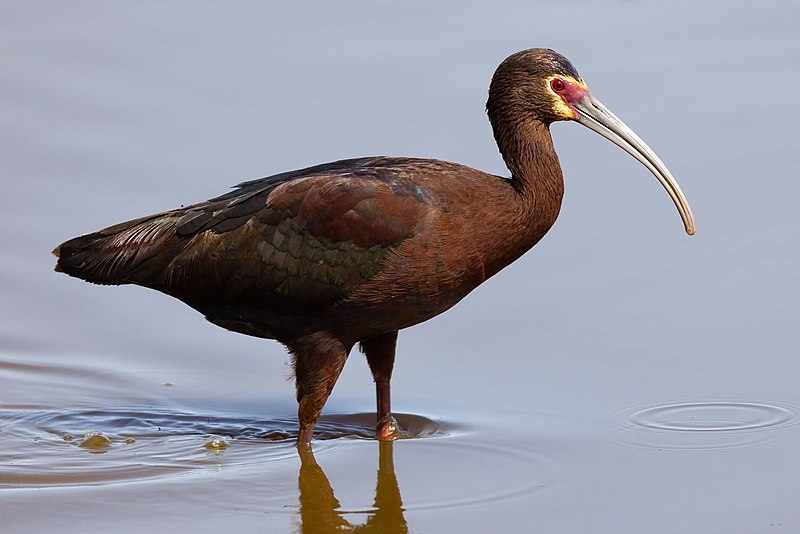
The White-faced Ibis is a species of wading bird belonging to the ibis family. It breeds in marshes, nesting on low trees or bushes.
The breeding range for this species stretches from western United States south through Mexico, and from southeastern Brazil and Bolivia all the way down to central Argentina and along the coast of Chile.
Its wintering grounds include coastal California, northern Arizona, New Mexico as well as Central America; it also occasionally occurs further north than usual due to favorable conditions.
This beautiful bird has white plumage with bronze wings that shine when seen under sunlight. Furthermore, its head is adorned by an unmistakable white face patch which gives it its name—White-faced Ibis.
Scientific classification:
| Kingdom | Animalia |
| Phylum | Chordata |
| Class | Aves |
| Order | Pelecaniformes |
| Family | Threskiornithidae |
| Genus | Plegadis |
| Species | P. chihi |
Also Featured In: Birds that Live in Tabasco, Common Birds of Antelope Island State Park
16. American Coot
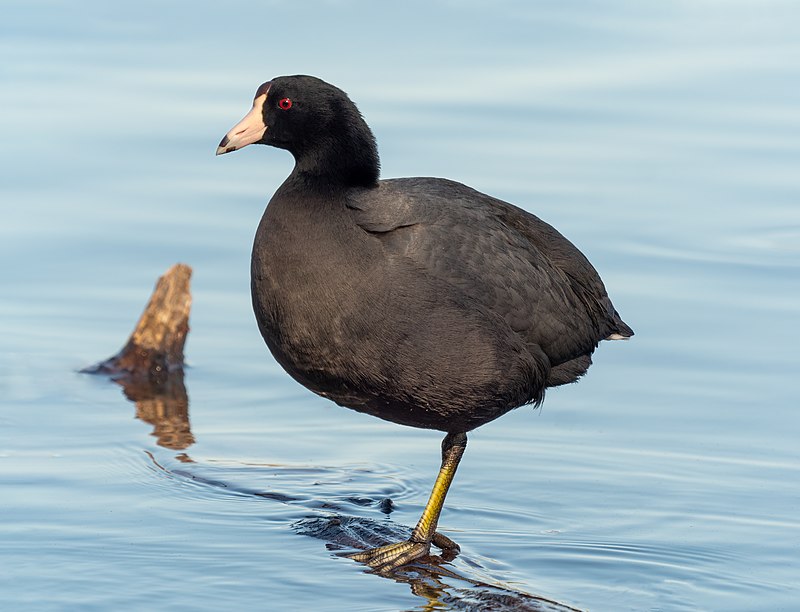
The American coot is a bird of the Rallidae family, commonly mistaken for ducks. However, they are only distantly related and have broad lobed scales on their lower legs and toes that fold back with each step to help them walk on dry land unlike ducks which have webbed feet.
Coots are omnivores who typically live in freshwater marshes, ponds and lakes but can also be found in brackish water habitats or even open oceans during migration season.
They feed mainly on algae and aquatic plants as well as small fish, snails, insects larvae and worms from time to time.
The males display territorial behaviour by chasing away intruders within their territory while females lay eggs mostly.
In floating nests made of vegetation near shorelines or islands among reeds where chicks hatch after about three weeks incubation period before swimming off into adulthood shortly afterwards at 10-12 weeks old.
Scientific classification:
| Kingdom | Animalia |
| Phylum | Chordata |
| Class | Aves |
| Order | Gruiformes |
| Family | Rallidae |
| Genus | Fulica |
| Species | F. americana |
17. Black-Necked Stilt
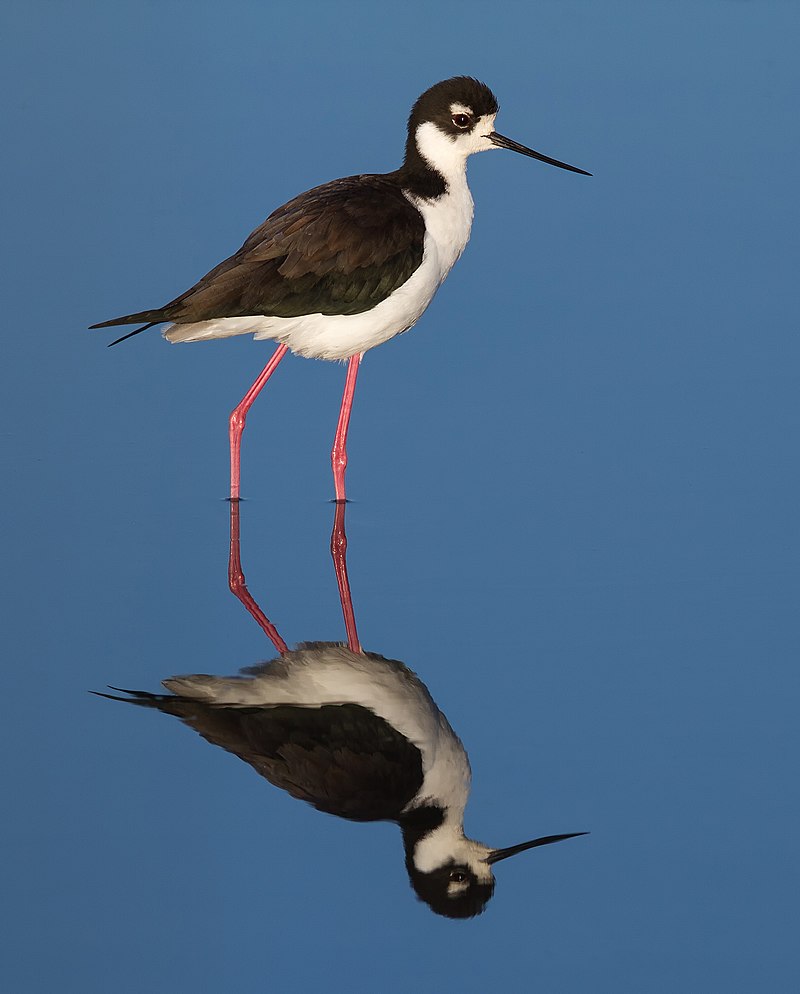
The Black-necked Stilt is an elegant shorebird that can be found from the coastal areas of California to Florida, then south through Central America and Brazil.
It has black upperparts contrasted by long white wings with a glossy sheen. Its striking red eyes are set against its white facial mask while its legs are bright pinkish in coloration.
The Haematopus mexicanus species inhabits marshy wetlands and brackish lagoons where it feeds on insects, crustaceans, small amphibians and fish which they catch using their slender bill or chase after them as they run across the surface of water or mudflats.
This bird typically nests near shallow waters but will use any habitat type if food resources are available nearby making it a highly adaptable species well suited for human altered habitats such as rice fields and sewage ponds.
Scientific classification:
| Kingdom | Animalia |
| Phylum | Chordata |
| Class | Aves |
| Order | Charadriiformes |
| Family | Recurvirostridae |
| Genus | Himantopus |
| Species | H. mexicanus |
18. House Finch

The House Finch is a species of finch native to western North America and has been introduced in the eastern half of the continent as well as Hawaii.
It’s an average-sized finch with adults measuring 12.5 – 15 cm (5 – 6 inches) long and having wingspans between 20 – 25 cm (8 – 10 inches).
The upperparts are brown, while its underparts range from pale grayish white to yellow depending on subspecies.
Its face is streaked or spotted with reddish coloration; males typically have brighter plumage than females due to sexual dimorphism.
They’re mostly found near human habitations such as farms and gardens where they feed on grains, fruits, insects etc., making them very popular among birders who want something colorful for their backyard.
Scientific classification:
| Kingdom | Animalia |
| Phylum | Chordata |
| Class | Aves |
| Order | Passeriformes |
| Family | Fringillidae |
| Subfamily | Carduelinae |
| Genus | Haemorhous |
| Species | H. mexicanus |
19. Pelecaniformes
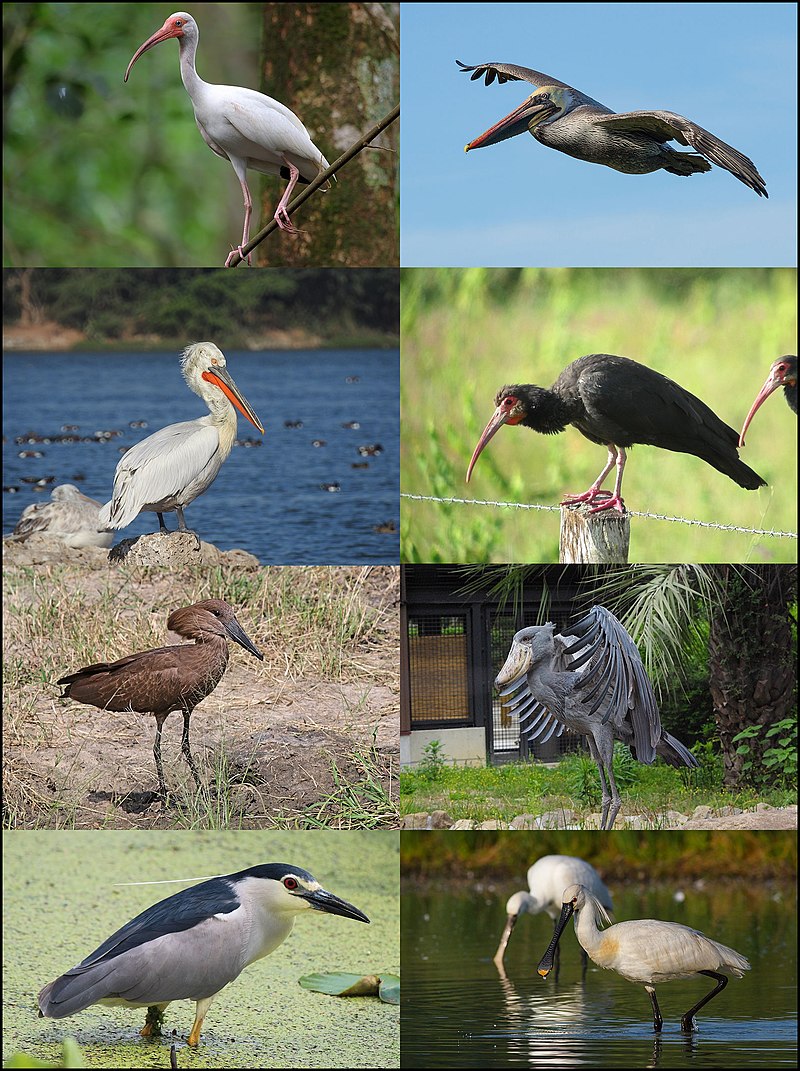
Pelecaniformes are a diverse order of waterbirds found all around the world. They vary in size, but most species are medium to large birds with webbed feet and a bare throat patch (gular patch).
Their nostrils have evolved into non-functional slits. Some examples include pelicans, gannets, cormorants and frigatebirds which can be found near coasts or on inland waters such as lakes or rivers.
Many Pelecaniforms fish for food by diving underwater from the air – some even swim underwater.
The diet of these birds consists mainly of small fishes although they may also eat mollusks, crustaceans and other aquatic creatures depending on their location.
All in all, Pelecaniformes make an important contribution to our planet’s biodiversity by keeping populations of fish under control while providing us with great views when we’re out exploring nature.
Scientific classification:
| Kingdom | Animalia |
| Phylum | Chordata |
| Class | Aves |
| Clade | Aequornithes |
| Order | Pelecaniformes Sharpe, 1891 |
Also Featured In: Birds that Live in Guyana, Common Species of Birds
20. Cinnamon-Tailed Sparrow
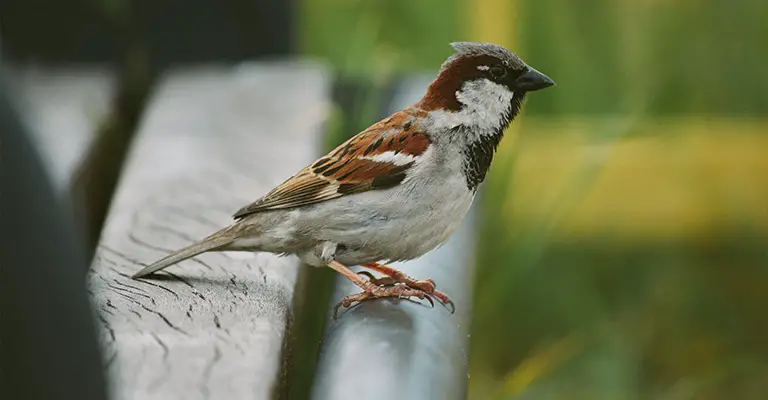
The Cinnamon-tailed Sparrow is a small bird living in Mexico. It belongs to the Passerellidae family and its habitat includes subtropical or tropical dry forests as well as shrublands.
The main threat for this species is habitat destruction, leading to a decline of population numbers over time. They have brown feathers on their upper bodies with white stripes across them, while the underparts are plain greyish-white.
Their tail has cinnamon coloration which gives these birds their name; it can be seen when they spread their wings out during flight.
This beautiful creature is currently endangered so conservation efforts should be made to ensure that future generations will still get to enjoy seeing them flit about in nature.
Scientific classification:
| Kingdom | Animalia |
| Phylum | Chordata |
| Class | Aves |
| Order | Passeriformes |
| Family | Passerellidae |
| Genus | Peucaea |
| Species | P. sumichrasti |
21. Boucard’s Wren
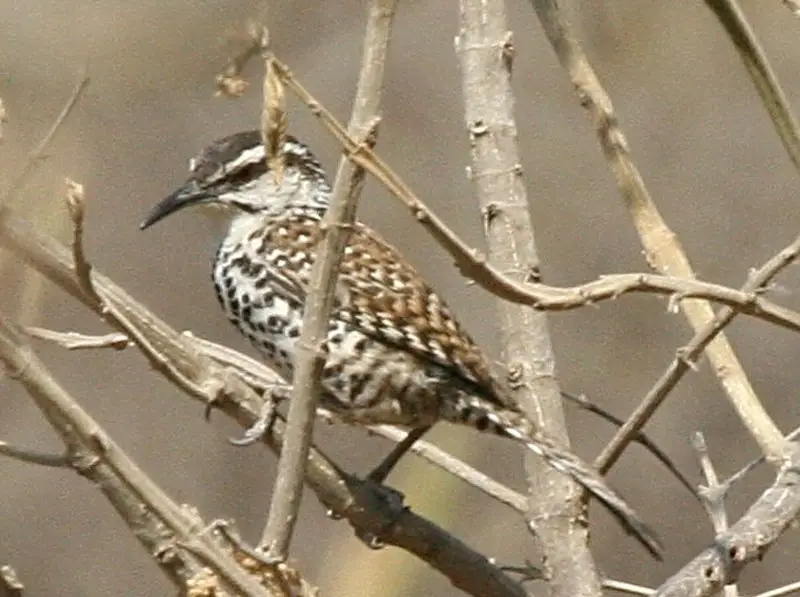
Boucard’s wren is an endemic bird species found only in Mexico. It belongs to the family Troglodytidae and has no subspecies. This small, sprightly bird measures 17 cm (6.7 in) long and weighs 23.8 to 29.8 g (0.84 – 1.05 oz).
Its upperparts are grayish-brown while its underparts are barred with white, brown or black streaks depending on the region where it is found; they also possess a distinctive pale yellow supercilium which extends from their bill up to the back of their neck .
Boucard’s Wrens mostly feed on insects but can also be seen foraging for seeds at times as well.
They often make short trilling calls during flight, adding songful music to our natural environment.
Scientific classification:
| Kingdom | Animalia |
| Phylum | Chordata |
| Class | Aves |
| Order | Passeriformes |
| Family | Troglodytidae |
| Genus | Campylorhynchus |
| Species | C. jocosus |
22. Grey-Breasted Woodpecker
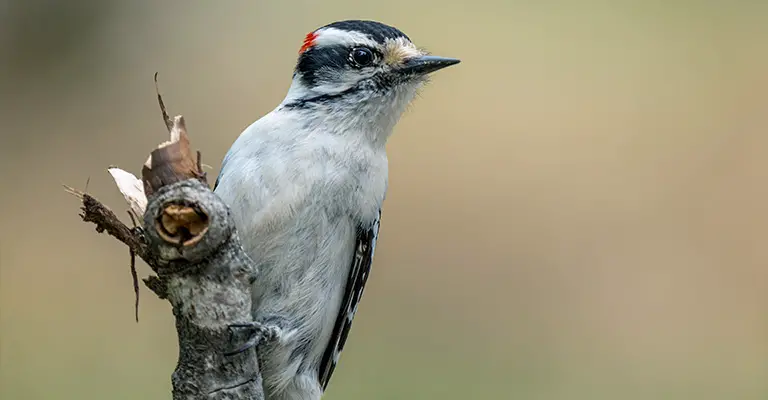
The Grey-breasted Woodpecker is a species of bird endemic to the interior of southwestern Mexico. Found in Guerrero, Morelos and Puebla, this elusive creature remained largely unknown until 1990 when a study conducted by the Cooper Ornithological Society revealed some fascinating insights into its behavior.
The birds were observed foraging on dead wood or tree trunks as well as cavities created by other woodpeckers; with their greyish brown plumage they have adapted perfectly to their arid environment.
They are also known for excavating nest cavities in trees and cacti where females lay two white eggs. A conservation effort should be made to protect these majestic creatures whose numbers could potentially decline if left unchecked due to habitat loss or illegal poaching activities.
Scientific classification:
| Kingdom | Animalia |
| Phylum | Chordata |
| Class | Aves |
| Order | Piciformes |
| Family | Picidae |
| Genus | Melanerpes |
| Species | M. hypopolius |
23. Cuckoos
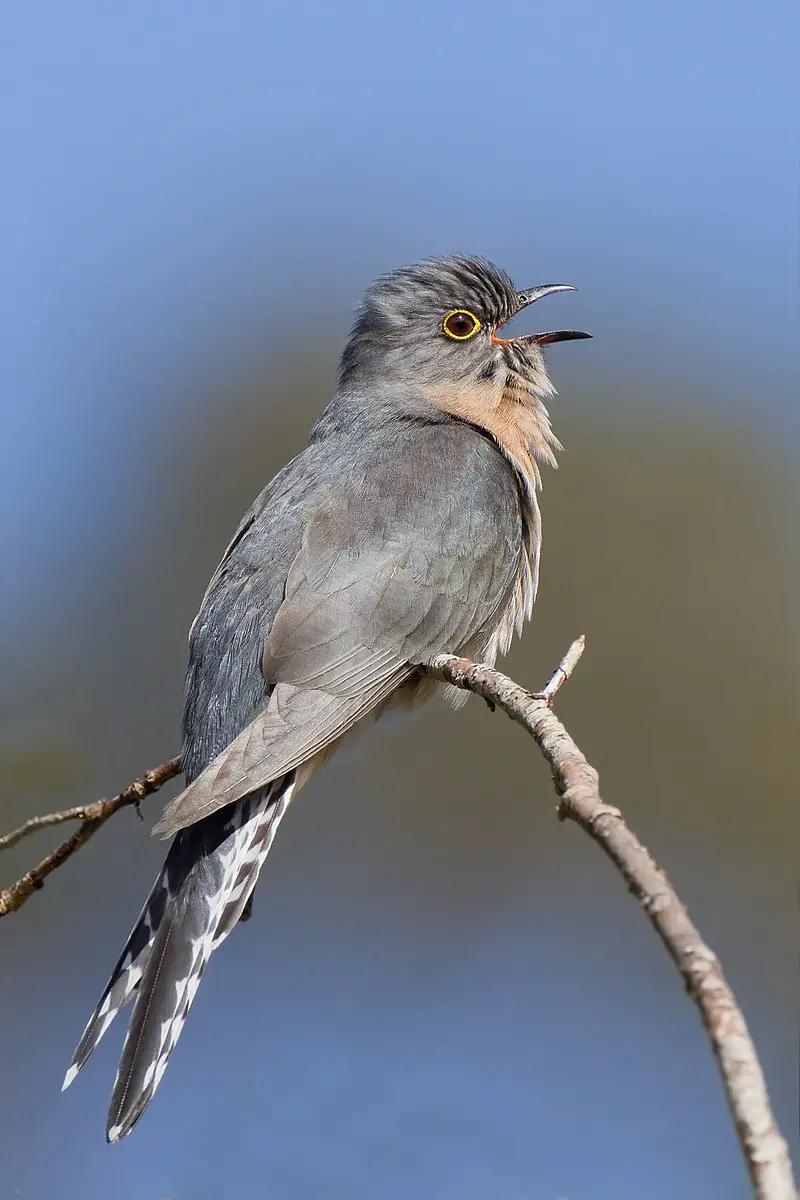
Cuckoos are fascinating birds belonging to the Cuculidae family, which is the only taxon in the order of Cuculiformes.
There are many different species within this family such as common or European cuckoo, roadrunners, koels, malkohas, couas and anis.
Some of these species may even be identified as separate families – Centropodidae and Crotophagidae respectively.
These birds have been known for their unique features such as loud calls heard consistently during certain times of day and night.
They also exhibit behavior like brood parasitism where they lay eggs in other nests so that their chicks can get more food from host parents than its own.
All these traits make them one-of-a-kind creatures worth admiring.
Scientific classification:
| Kingdom | Animalia |
| Phylum | Chordata |
| Class | Aves |
| Clade | Otidimorphae |
| Order | Cuculiformes Wagler, 1830 |
| Family | Cuculidae Leach, 1820 |
24. Rufous-Capped Brushfinch
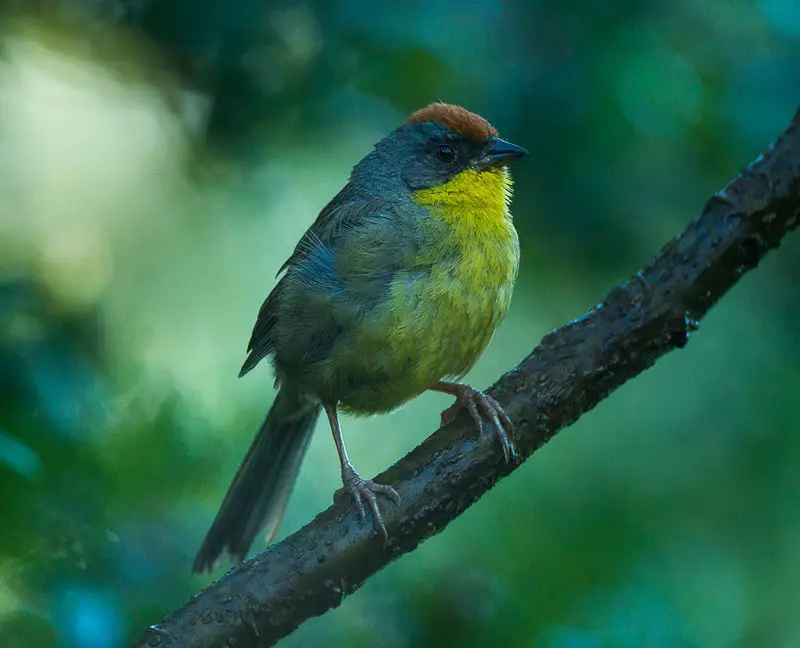
The Rufous-capped brushfinch is a species of bird found in Mexico. It has unique features, with its distinctive rufous-coloured cap and greyish upperparts.
It inhabits moist montane forests as well as high altitude shrubland areas. This songbird feeds mainly on insects such as beetles, ants, grasshoppers and moths which they catch while foraging on the ground or atop low vegetation.
They are mostly solitary birds but can also be seen in pairs during breeding season when they nest under dense shrubs or trees near water bodies or along forest edges.
The conservation status of this species is considered Least Concern by IUCN due to its wide range and stable population trend across different parts of Mexico however it still faces threats from deforestation activities carried out for agricultural purposes which need to be addressed soon for their long term survival .
Scientific classification:
| Kingdom | Animalia |
| Phylum | Chordata |
| Class | Aves |
| Order | Passeriformes |
| Family | Passerellidae |
| Genus | Atlapetes |
| Species | A. pileatus |
25. Hooded Yellowthroat
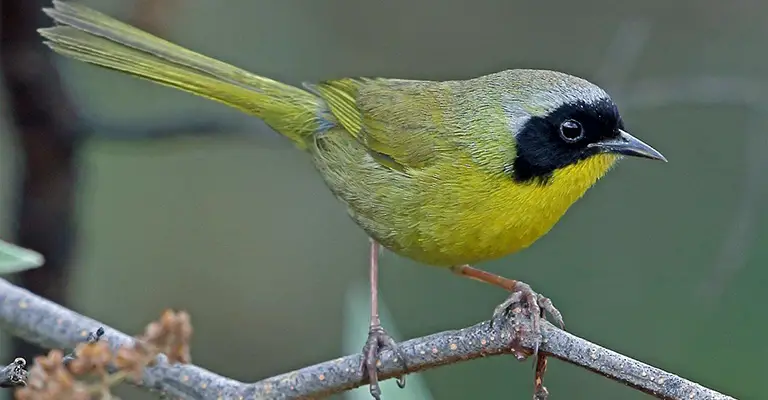
The Hooded Yellowthroat is a species of bird found in Mexico. It resides mainly in dense shrubland and chaparral, from semi-arid to humid montane regions north of the Isthmus of Tehuantepec.
With its bright yellow throat and chestnut brown hood, this small songbird has an unmistakable appearance. In terms of vocalizations, it’s well known for producing continuous trills that can last up to 10 seconds long.
The diet consists mostly insects as well as some fruits and seeds that they find while hopping around on the ground or among low bushes looking for food.
To nest, these birds construct a cup out of twigs lined with grasses which is usually placed close to the ground amongst thick vegetation away from predators.
All things considered, the Hooded Yellowthroat is an interesting little creature full of surprises waiting to be discovered by curious minds.
Scientific classification:
| Kingdom | Animalia |
| Phylum | Chordata |
| Class | Aves |
| Order | Passeriformes |
| Family | Parulidae |
| Genus | Geothlypis |
| Species | G. nelsoni |
26. American White Pelican

The American White Pelican is a majestic bird from the Pelecaniformes order, known for its impressive size and ability to soar gracefully in the sky.
It breeds during summer months in North America and migrates southwards towards Central and South America during winter.
The species was first described by German naturalist Johann Friedrich Gmelin back in 1789 as part of his updated version of Carl Linnaeus’ work.
This large aquatic bird has an all-white plumage with black primary flight feathers on its wings, while its beak features a characteristic yellowish colouration at the base near the face.
Its diet mainly consists of fish which it typically catches after dipping into water using its long bill; yet sometimes they can be seen stealing food items from other birds such as cormorants or gulls.
Scientific classification:
| Kingdom | Animalia |
| Phylum | Chordata |
| Class | Aves |
| Order | Pelecaniformes |
| Family | Pelecanidae |
| Genus | Pelecanus |
| Species | P. erythrorhynchos |
27. Long-Tailed Wood Partridge
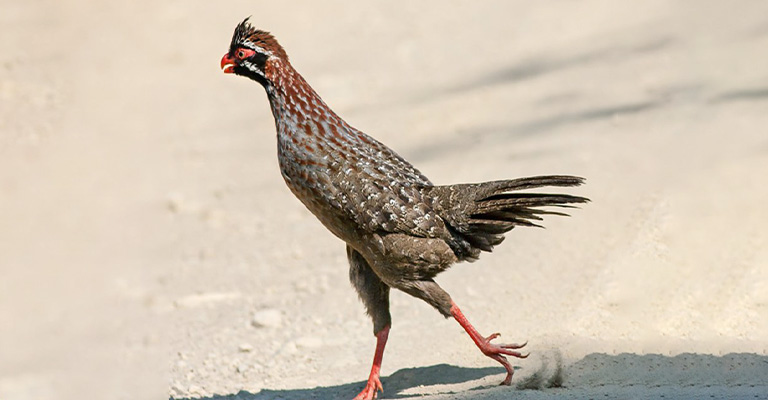
The Long-tailed Wood Partridge is a species of bird found only in Mexico, belonging to the family Odontophoridae.
It has six subspecies and measures 11.4 – 16.6 inches (29 – 42 cm) long with its namesake long tail accounting for almost two thirds of that length.
Its plumage is mostly greyish brown but can range from purple through chestnut red to olive green depending on its location and time of year.
This partridge does not migrate nor live in flocks as other quail do, instead living alone or in pairs near forest edges where there are plenty of low bushes for cover against predators such as foxes and coyotes which it will hide from if disturbed by running into thick vegetation or flying short distances away from them when possible.
Scientific classification:
| Kingdom | Animalia |
| Phylum | Chordata |
| Class | Aves |
| Order | Galliformes |
| Family | Odontophoridae |
| Genus | Dendrortyx |
| Species | D. macroura |
28. Yellow-Footed Gull
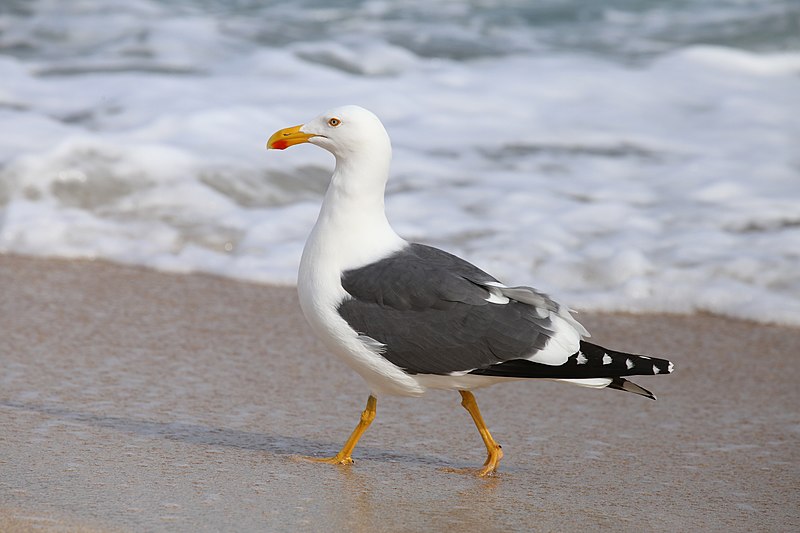
The Yellow-footed Gull is a large seabird endemic to the Gulf of California. It has a white head, dark slate colored wings and back, and a thick yellow bill with yellow legs (pink in young birds).
In appearance it is quite similar to its relative the Western Gull but was classified as a separate species until around 1960.
This bird feeds mainly on small fish found near shorelines which it catches by diving into shallow waters from heights up to 20m above sea level.
As well as being an efficient hunter they are also renowned scavengers that feed at dumps or follow fishing boats for scraps.
They have even been seen eating jellyfish. A range of conservation measures including protection given under Mexican law means this beautiful bird can be enjoyed long into the future.
Scientific classification:
| Kingdom | Animalia |
| Phylum | Chordata |
| Class | Aves |
| Order | Charadriiformes |
| Family | Laridae |
| Genus | Larus |
| Species | L. livens |
Also Featured In: Common Birds of Baja California,
29. Canyon Towhee
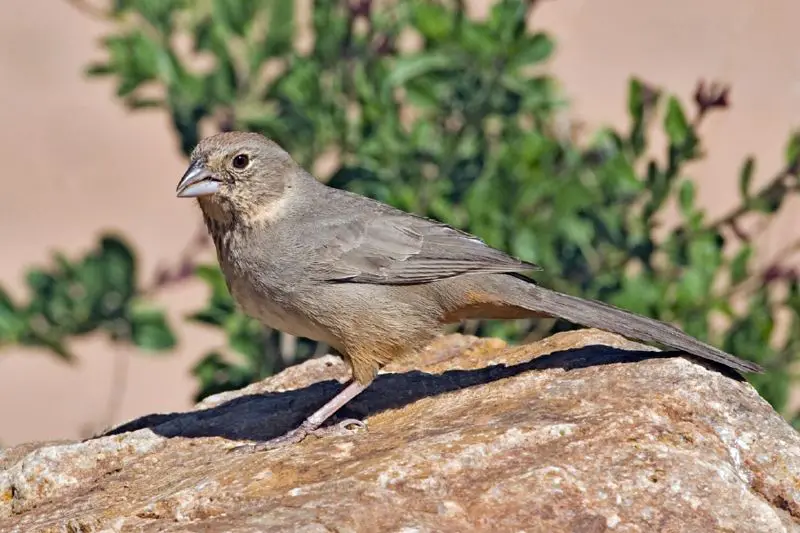
The Canyon Towhee is a small bird belonging to the Passerellidae family. It has an olive-brown head and back, with a greyish white belly and chest. The wings are darker than the body, while its tail feathers are brown in color.
This species resides near dry canyons, hence their name; however it inhabits other woodlands as well. Its diet consists of seeds, fruits, insects and some grasses too.
They generally forage or search for food on ground level but also occasionally pick up food from tree branches or shrubs as well.
During breeding season they engage in courtship displays by bowing low with spread tails that vibrate rapidly before taking flight into the air singing songs all along.
Scientific classification:
| Kingdom | Animalia |
| Phylum | Chordata |
| Class | Aves |
| Order | Passeriformes |
| Family | Passerellidae |
| Genus | Melozone |
| Species | M. fusca |
Also Featured In: Birds that Live in Arizona Desert, Brown Birds that Found in Texas
30. Broad-Billed Hummingbird
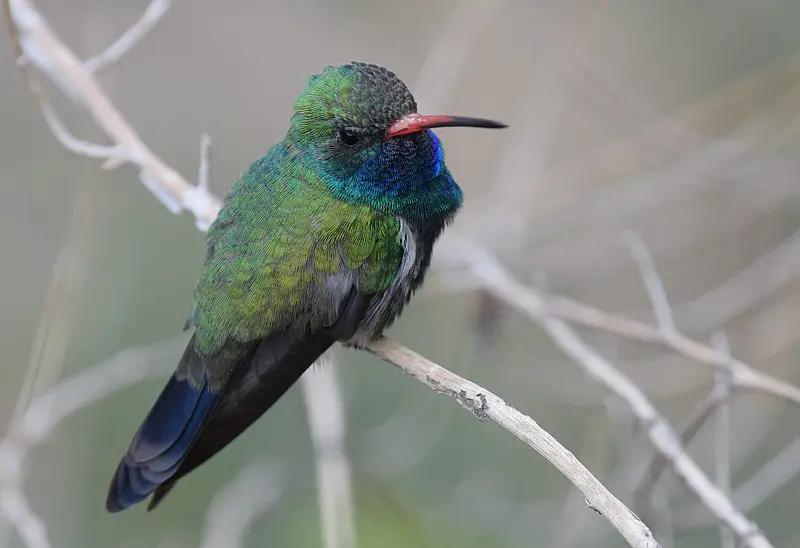
The Broad-billed Hummingbird is a small species of hummingbird that can be found in Mexico and the southwestern United States.
It has distinctive sexual dimorphism, with females resembling their juvenile counterparts more than males do.
This bird stands out thanks to its bright colors and broad, red bill. Other common names for this species include Colibri Mexicano (Spanish) or Mexican Hummingbird.
The Broad-billed usually nests on trees or shrubs near streams but may also occupy wooded areas or gardens close by human settlements during wintertime.
They feed mainly on nectar from flowers while supplementing their diet with insects depending on availability of prey items as well as seasonality changes throughout their range area.
Scientific classification:
| Kingdom | Animalia |
| Phylum | Chordata |
| Class | Aves |
| Order | Apodiformes |
| Family | Trochilidae |
| Genus | Cynanthus |
| Species | C. latirostris |
Also Featured In: Summer Birds that Live around Us, Green Birds in That Live in Texas
31. Lesser Goldfinch
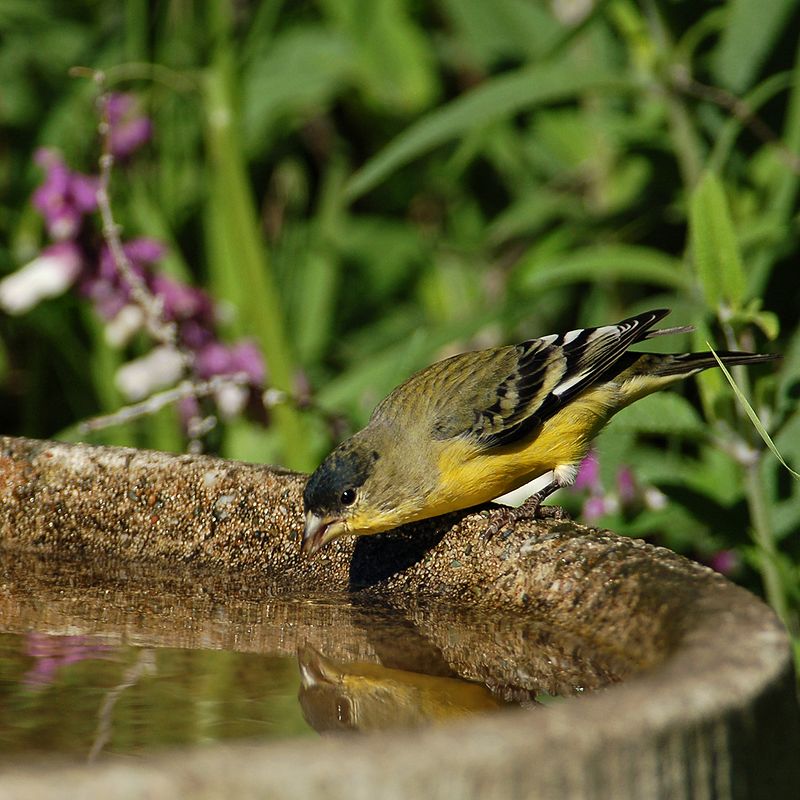
The Lesser Goldfinch is a tiny species of bird found in the Americas. It belongs to the same clade as American goldfinches and Lawrence’s goldfinches, which can be identified by their males having black or rarely green foreheads.
The face appears red or yellow on these birds unlike other species in its genus Spinus sensu stricto.
They are small songbirds with short bills, brown wings and tails with white edges, grey-brown backs and olive heads.
These birds inhabit open woodlands and fields where they feed mainly on seeds from weeds such as thistle, pigweed and ragweed but also consume insects at times during breeding season for additional nutrition.
In addition to being an important part of North America’s avian ecology, these birds have been popularized through recent artwork depicting them in various poses among flowers.
Scientific classification:
| Kingdom | Animalia |
| Phylum | Chordata |
| Class | Aves |
| Order | Passeriformes |
| Family | Fringillidae |
| Subfamily | Carduelinae |
| Genus | Spinus |
| Species | S. psaltria |
Also Featured In: Birds That Live in Colorado, Birds Live Near San Diego
32. Colima Pygmy Owl
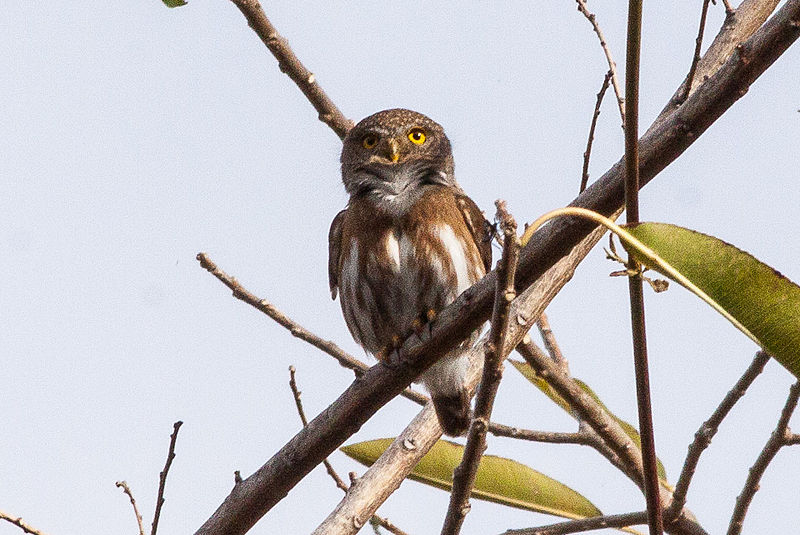
The Colima pygmy owl is a species of owl endemic to the western part of Mexico. It belongs to the family Strigidae and typically grows up to 8–9 inches in length, with males being slightly smaller than females.
The International Ornithological Committee recognizes three subspecies: G. palmarum palmarum, G. p oberholseri and G .p g.
They are mostly active during twilight hours when they hunt for small mammals like mice or voles from their perches atop trees or shrubs using their excellent hearing capabilities along with sharp eyesight which allows them superior vision even at night time.
During daytime, these owls can be found roosting on tree branches keeping cool under shady foliage while also remaining camouflaged amongst its surroundings due to its grey-brown coloration that helps it blend into bark patterns perfectly.
Scientific classification:
| Kingdom | Animalia |
| Phylum | Chordata |
| Class | Aves |
| Order | Strigiformes |
| Family | Strigidae |
| Genus | Glaucidium |
| Species | G. palmarum |
Also Featured In: Most Common Birds in Michoacán,
33. Magnificent Frigatebird
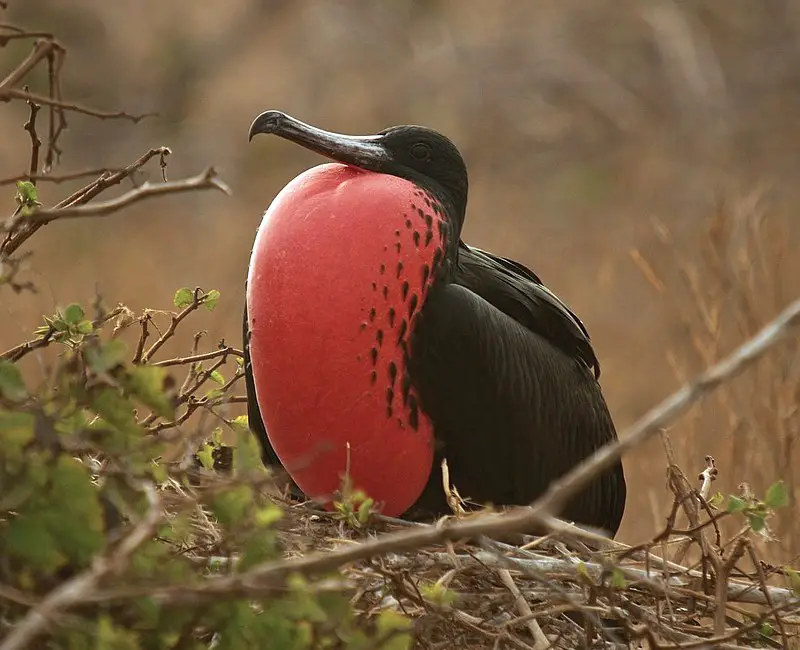
The Magnificent Frigatebird is the largest species of frigatebird, measuring between 89 and 114 cm in length and having a wingspan of 7-8 ft.
It can be found over tropical waters off America from northern Mexico to Peru on the Pacific coast, as well as Florida down south.
Its diet consists mainly of fish they take from other seabirds or snatch directly from the ocean surface while flying low above it.
They also feed on crustaceans and squid when available too.
This impressive bird has an unmistakable silhouette with its long pointed wings, forked tail feathers and male’s red gular pouch which inflates during courtship displays.
Scientific classification:
| Kingdom | Animalia |
| Phylum | Chordata |
| Class | Aves |
| Order | Suliformes |
| Family | Fregatidae |
| Genus | Fregata |
| Species | F. magnificens |
Also Featured In: Birds that Live in the Ocean , Most Common Birds in South America Birds
34. Eurasian Collared Dove
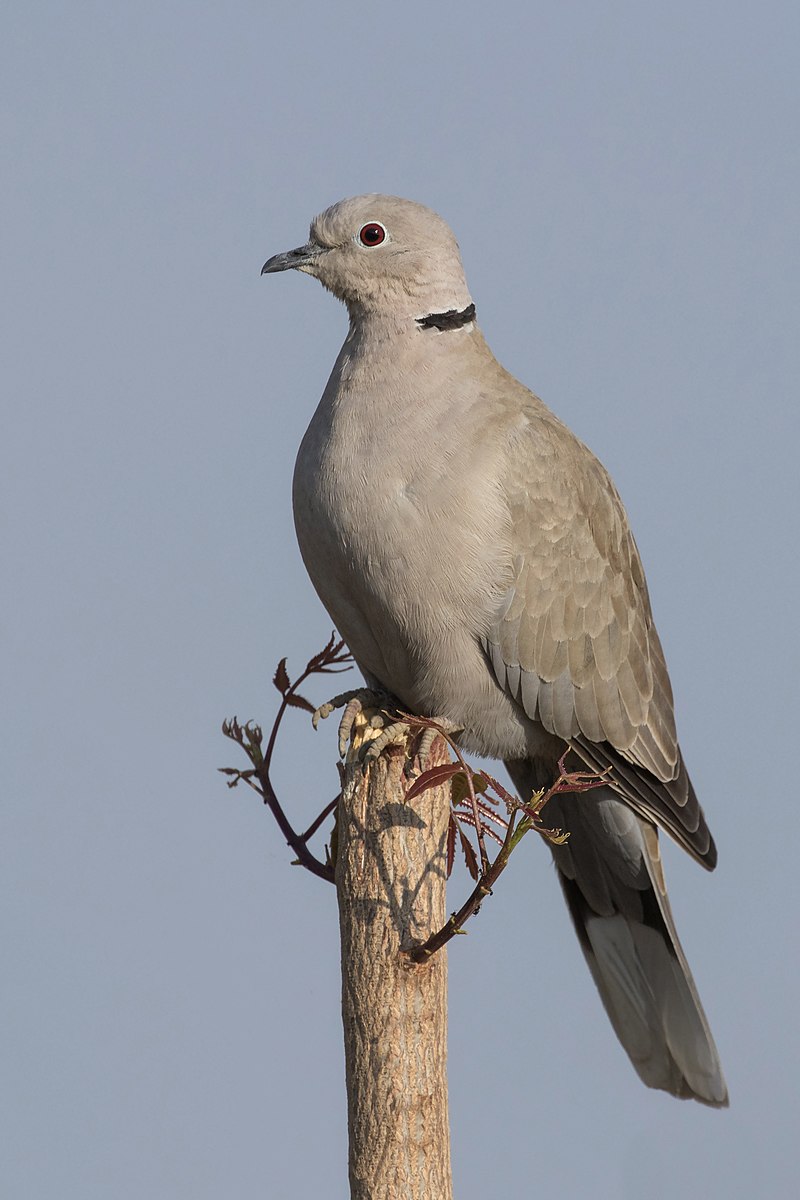
The Eurasian collared dove is a species of bird native to Europe and Asia, with its range expanding through introduction in Japan, North America, and islands in the Caribbean.
It has become so widespread that it is listed as Least Concern on the IUCN Red List. The scientific name for this bird was proposed by Hungarian naturalist Imre Frivaldsz – Columba decaocto.
This beautiful creature typically measures between 33-37 cm from tip to tail feathers, displaying an overall greyish brown plumage; they also have distinctive black half collar around their neck which gives them their common name.
These birds are mainly found inhabiting open woodlands or agricultural lands near human settlements where there’s plenty of food available such as grain fields or gardens where fruits can be eaten off trees.
With a vast global population trend increasing steadily each year these birds make great additions to many backyards throughout the world.
Scientific classification:
| Kingdom | Animalia |
| Phylum | Chordata |
| Class | Aves |
| Order | Columbiformes |
| Family | Columbidae |
| Genus | Streptopelia |
| Species | S. decaocto |
Also Featured In: Turkey Birds You Should Know, Ukrainian Birds You Should Know
35. Ruddy Ground Dove
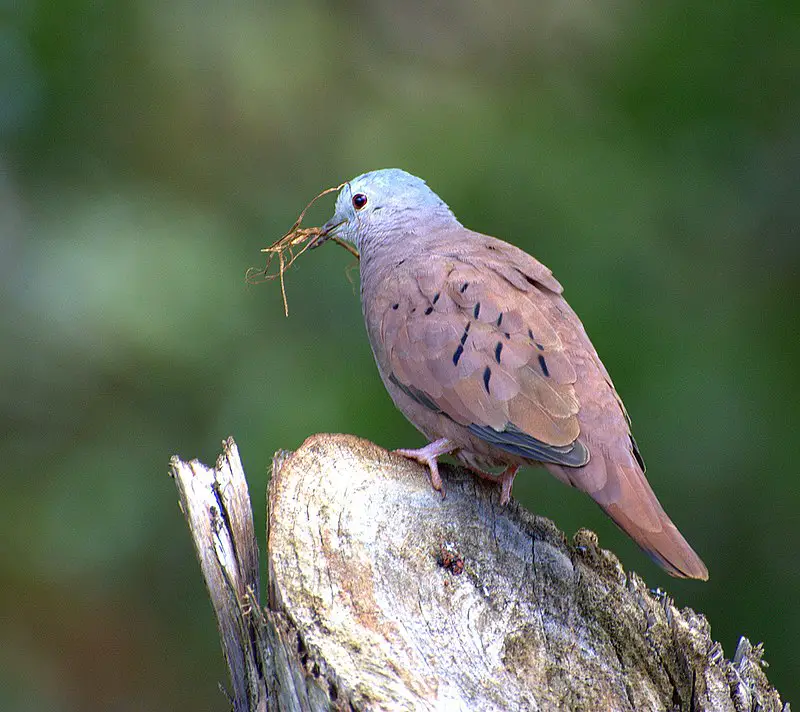
The Ruddy Ground Dove is a small New World tropical bird, found across Mexico and South America as far south as Argentina. It is also seen in the southwestern United States during winter months.
This ground dove typically lives in scrub or other open habitats such as savannas and grasslands, where it feeds on seeds from plants like cactus fruits.
Its plumage ranges from grey to reddish-brown with a light tan breast and black markings throughout its wings and tail feathers.
The male has more distinguishable colouration than the female but both sexes have bright red eyes which give this species its name – ‘ruddy’.
They are often observed perching low to the ground near food sources or nesting sites while also being quite vocal when flying between locations making them easier to spot.
Scientific classification:
| Kingdom | Animalia |
| Phylum | Chordata |
| Class | Aves |
| Order | Columbiformes |
| Family | Columbidae |
| Genus | Columbina |
| Species | C. talpacoti |
Also Featured In: Common Birds of Guerrero,
36. Green Heron
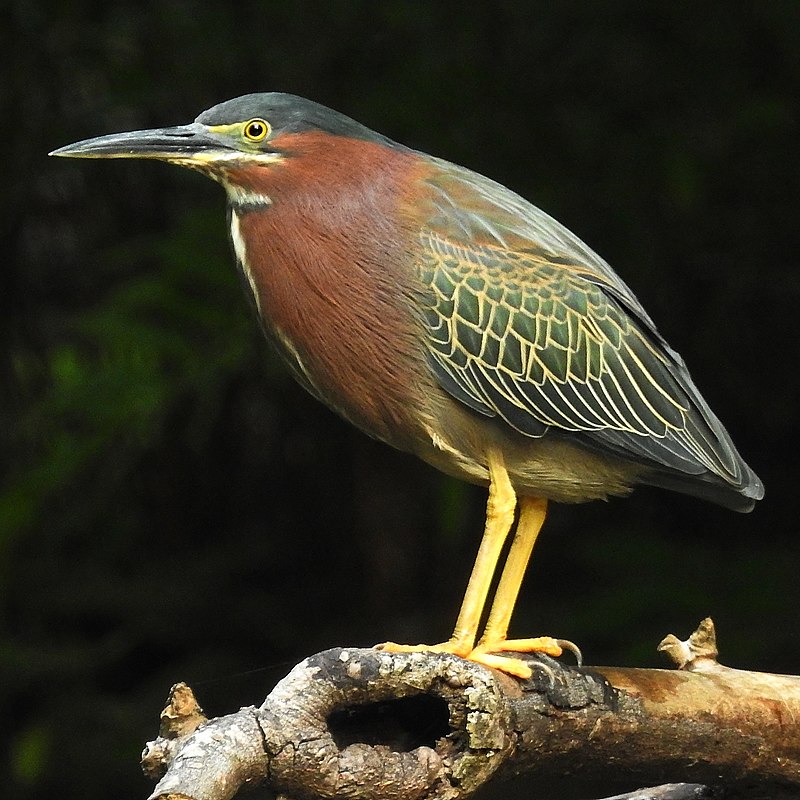
The Green Heron (Butorides virescens) is a small heron found throughout North and Central America.
It’s scientific name comes from Middle English ‘butor’ meaning bittern, combined with the Latin term for its distinctive greenish color – ‘virescens’.
For many years it was considered to be part of the same species as the Striated Heron (Butorides striata), commonly referred to as “green-backed herons”.
The nominate subspecies inhabits wetlands across much of this range, where they can be spotted stalking about in shallow water looking for fish or frogs on which to feed.
They are fascinating wading birds that have even been known to use tools such as sticks or baited lines when fishing.
Scientific classification:
| Kingdom | Animalia |
| Phylum | Chordata |
| Class | Aves |
| Order | Pelecaniformes |
| Family | Ardeidae |
| Genus | Butorides |
| Species | B. virescens |
Also Featured In: Birds that You’ll Find in Puerto Rico, Swamps Birds You Should Know
37. American Avocet
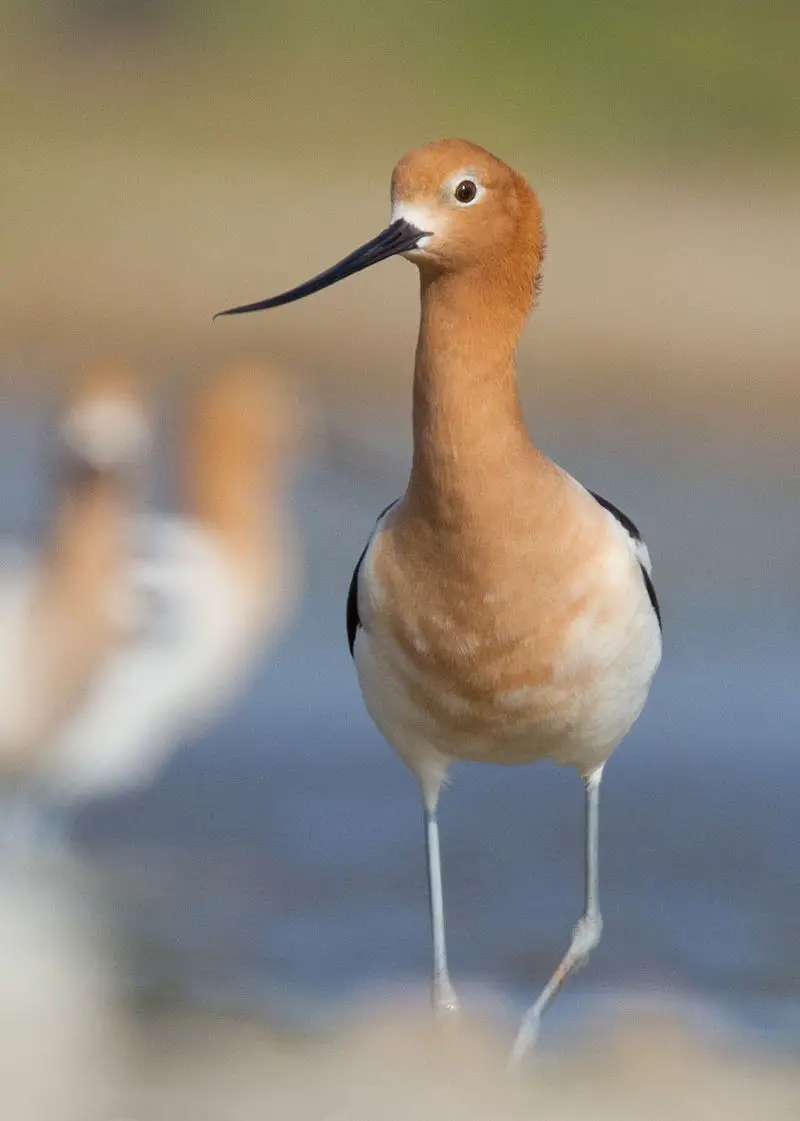
The American avocet is a stunningly beautiful bird found in North America. With its striking black and white plumage, long blue legs, and upturned bill it is an unmistakable sight.
It spends much of its time foraging around shallow water or mud flats searching for crustaceans and insects to feed on by sweeping its beak from side-to-side through the water.
The German naturalist Johann Friedr formally described this species back in 1789 as Recurvirostra americana – aptly named due to their habit of recurving their bills when feeding.
These graceful wading birds are truly a marvel of nature that deserve our admiration.
Scientific classification:
| Kingdom | Animalia |
| Phylum | Chordata |
| Class | Aves |
| Order | Charadriiformes |
| Family | Recurvirostridae |
| Genus | Recurvirostra |
| Species | R. americana |
38. Russet Nightingale-Thrush
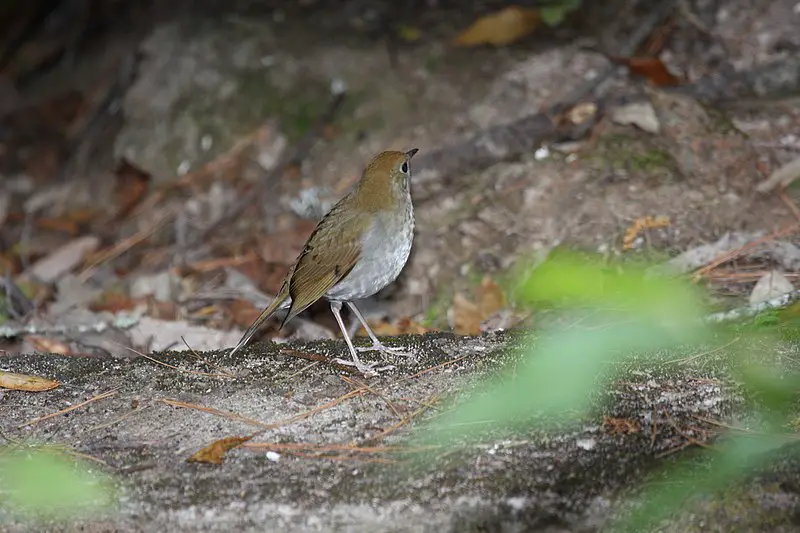
The Russet Nightingale-Thrush is a beautiful species of bird found exclusively in Mexico. It has a brown crown, back and wings with a pale gray face and throat.
Its belly is also pale gray but washed dusky for an extra touch of colour. The juveniles are even more mottled on their breasts and sides adding to its beauty.
This bird shares many similar traits as the Ruddy-Capped Nightingale Thrush making it easy to confuse them if you’re not paying attention.
Overall this stunning creature makes an amazing addition to any environment they inhabit.
Scientific classification:
| Kingdom | Animalia |
| Phylum | Chordata |
| Class | Aves |
| Order | Passeriformes |
| Family | Turdidae |
| Genus | Catharus |
| Species | C. occidentalis |
39. Green-Striped Brushfinch
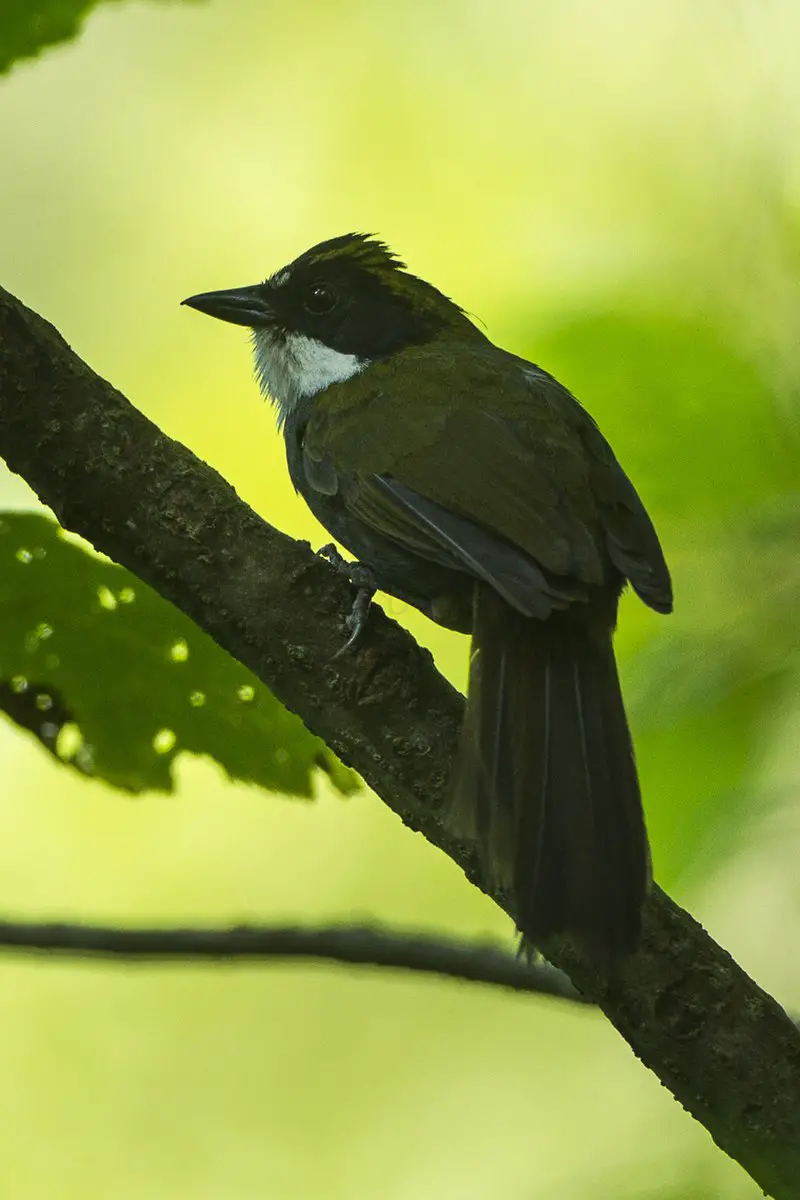
The Green-striped brushfinch is a species of bird found in Mexico, that belongs to the family Passerellidae.
This small finch has green stripes across its head and upper body, making it stand out from other birds in the area.
They tend to inhabit subtropical or tropical moist montane forests where they can find plenty of food sources such as insects and fruits.
These birds are sociable creatures who like living with their own kind, forming flocks that travel around together looking for food sources during the day before returning back home at nightfall.
The Green-striped brushfinch is an important part of any ecosystem since they help keep insect populations down by consuming them on regular basis while also dispersing seeds through droppings which helps increase plant diversity over time.
Scientific classification:
| Kingdom | Animalia |
| Phylum | Chordata |
| Class | Aves |
| Order | Passeriformes |
| Family | Passerellidae |
| Genus | Arremon |
| Species | A. virenticeps |
40. Black-Backed Oriole
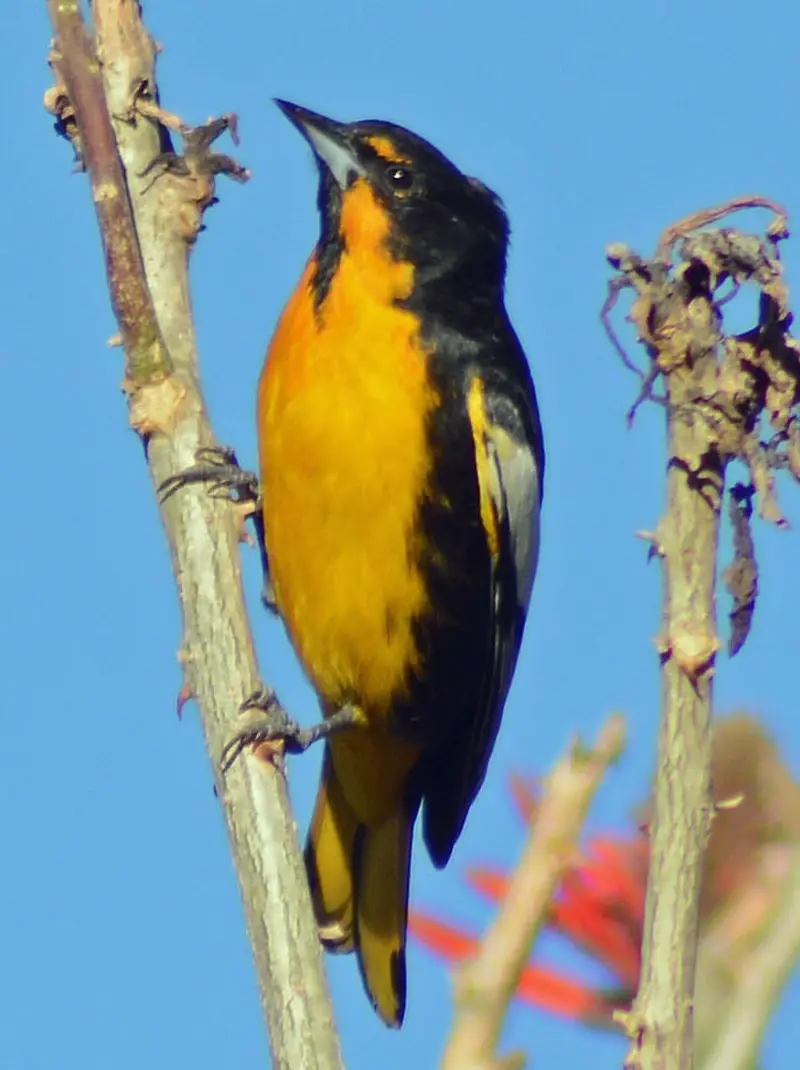
The black-backed oriole is a species of bird found in Mexico, typically residing within subtropical or tropical moist lowland forests and montane forests.
It has also been known to take up residence in cities as well. One unique trait the black-backed oriole possesses is its tolerance for monarch butterflies; while most birds cannot stomach their poison, this particular species can consume them with ease.
This makes it one of only a few species that are capable of such an adaptation. Its feathers range from bright yellow on the chest to deep browns at the back – making it easy to identify amongst other Mexican fauna.
Scientific classification:
| Kingdom | Animalia |
| Phylum | Chordata |
| Class | Aves |
| Order | Passeriformes |
| Family | Icteridae |
| Genus | Icterus |
| Species | I. abeillei |
41. Brown-Headed Cowbird
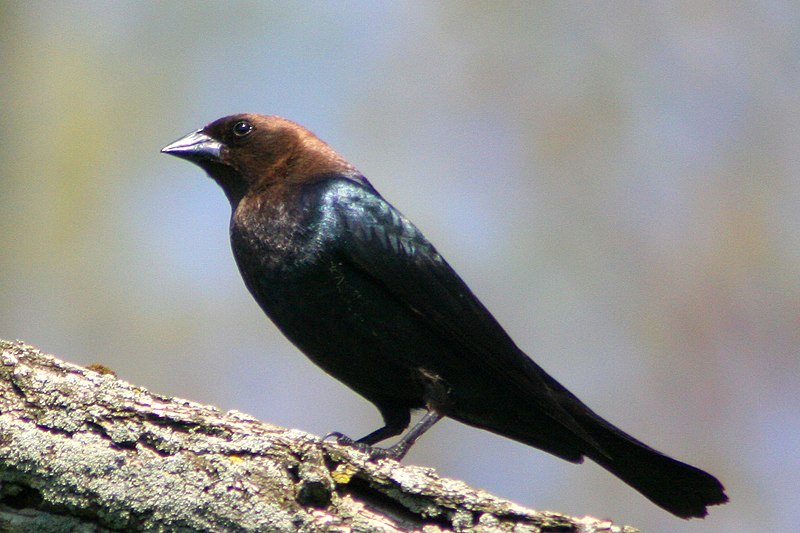
The Brown-headed Cowbird is a small, obligate brood parasitic icterid native to temperate and subtropical North America. It has a brown head with glossy black plumage on the body, wings and tail feathers.
During summer months it can be found in prairies, grasslands as well as open wooded areas but during winter they migrate southwards towards the United States of Mexico for warmer climate.
They are mainly insectivorous birds which feed on insects like caterpillars or beetles but also consume some grains too.
The female bird lays its eggs in nests of other species who then incubates them until hatching time thus leaving their own chicks uncared for by themselves.
Scientific classification:
| Kingdom | Animalia |
| Phylum | Chordata |
| Class | Aves |
| Order | Passeriformes |
| Family | Icteridae |
| Genus | Molothrus |
| Species | M. ater |
42. Turkey Vulture
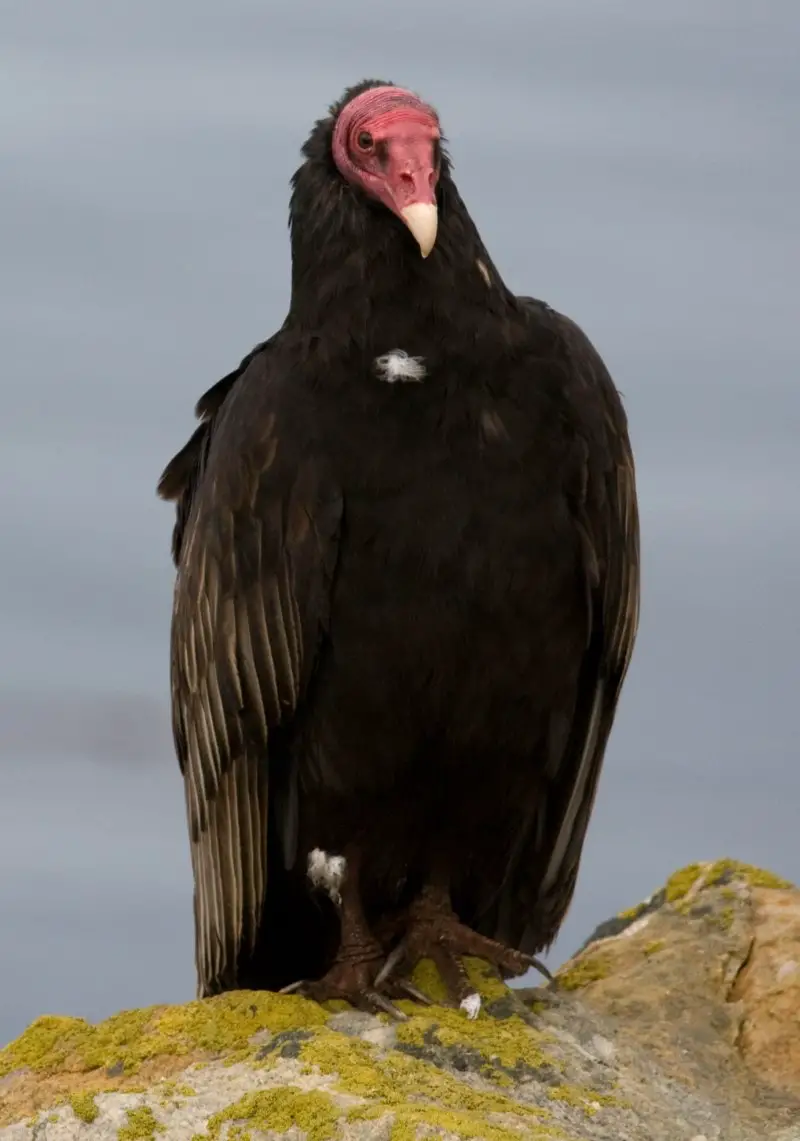
The turkey vulture is a large bird of prey that can be found in many parts of the world. It has a wingspan of up to 6 feet and its feathers are mostly black with brownish-red patches on the underside which give it an overall dark red appearance.
Its head is bald, which helps protect it from getting overheated when flying long distances looking for food.
The Turkey Vulture usually feeds off carrion but will also feed on fruit and insects.
Its keen eyesight allows them to spot potential meals from miles away while they soar through the sky using their broad wings and thermal air currents to stay aloft without expending much energy.
They are very important scavengers as they keep ecosystems healthy by consuming dead animals before disease can spread amongst living creatures or contaminate local water sources like rivers or lakes
Scientific classification:
| Kingdom | Animalia |
| Phylum | Chordata |
| Class | Aves |
| Order | Accipitriformes |
| Family | Cathartidae |
| Genus | Cathartes |
| Species | C. aura |
Also Featured In: Birds You’ll Find in Zoo, Central Texas Birds
43. American White Ibis
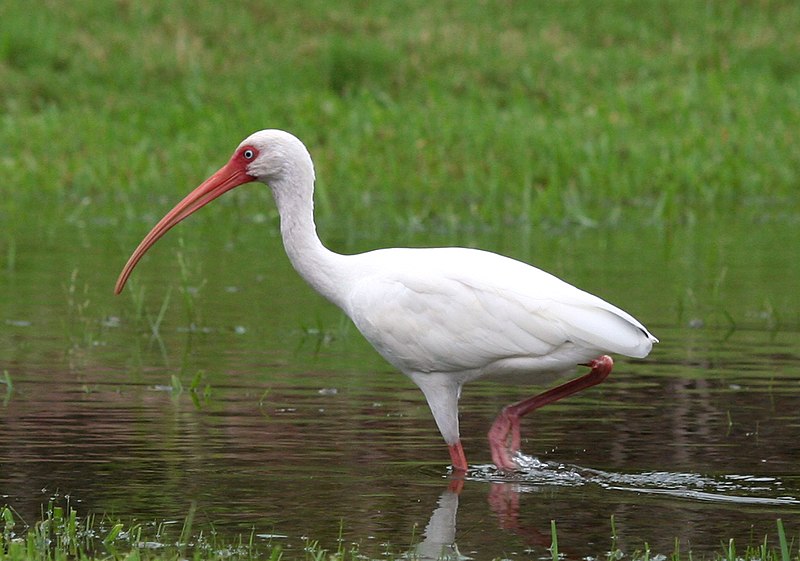
The American white ibis is a medium-sized bird with an overall white plumage and long legs. It has a bright red-orange downward curved bill, and black wing tips that are usually only visible in flight.
This species of ibis can be found from Virginia south through most of the coastal New World tropics.
They have been known to inhabit marshes, swamps, ponds, lakeshores as well as mangrove forests near water sources where they feed on crustaceans such as crabs and shrimp among other aquatic animals like insects or snails.
The American white ibis plays an important role in its ecosystem by helping to control insect populations which helps maintain balance within these environments.
Scientific classification:
| Kingdom | Animalia |
| Phylum | Chordata |
| Class | Aves |
| Order | Pelecaniformes |
| Family | Threskiornithidae |
| Genus | Eudocimus |
| Species | E. albus |
Also Featured In: Everglades Birds, Birds that Live around Southwest Florida
44. Lesser Yellowlegs
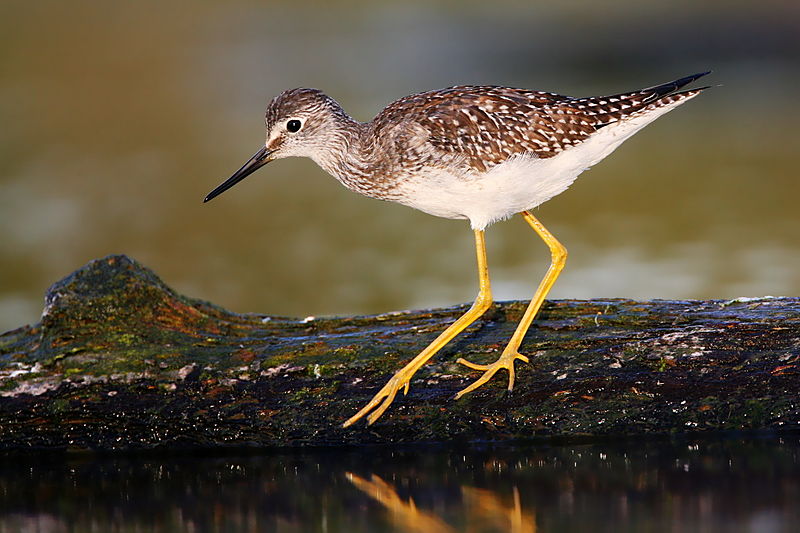
The Lesser Yellowlegs is a medium-sized shorebird found in the boreal forest region of North America.
It was described by German naturalist Johann Friedrich Gmelin in 1789 and placed it into the genus Scolopax.
This species has buff upperparts, white underparts, yellow legs and feet, olive green wings with white edges on its secondaries and tertials as well as a thin black bill which curves downward towards its tip.
The male lesser yellowlegs are slightly larger than females and can be distinguished from other waders due to their unique call; they will often make loud “tchew” or “churr” noises when alarmed during breeding season.
They typically feed on small aquatic insects such as beetles, flies, moths etc., but may also eat crustaceans such as shrimp or water snails if available.
Scientific classification:
| Kingdom | Animalia |
| Phylum | Chordata |
| Class | Aves |
| Order | Charadriiformes |
| Family | Scolopacidae |
| Genus | Tringa |
| Species | T. flavipes |
Also Featured In: Birds in Calgary You’ll Love to See, Common Birds in Prince Edward Island
45. Long-Billed Dowitcher
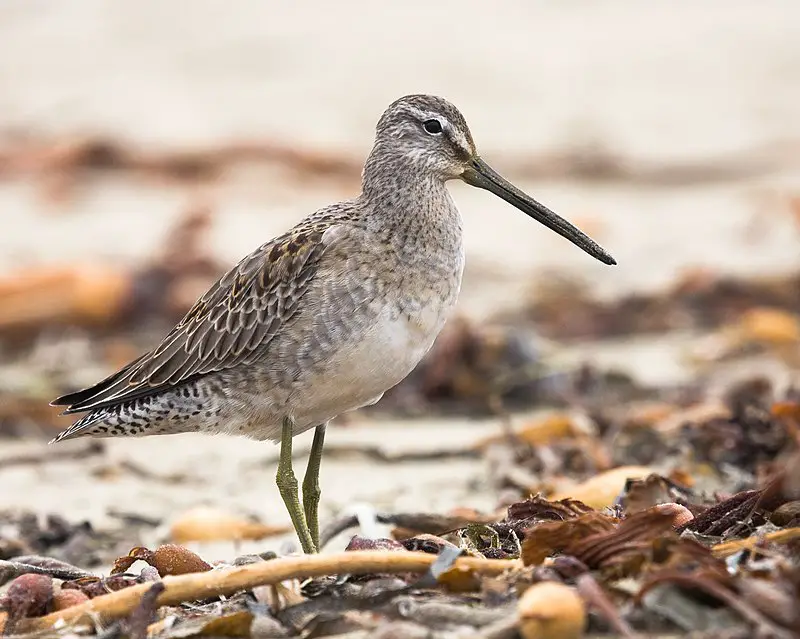
The Long-billed Dowitcher is a beautiful shorebird with an unmistakable long bill. During breeding season, they are characterized by their rufous head and underparts combined with a dark mottled back and large white upper rump only visible when in flight.
These birds can be found in freshwater habitats all over the world, where they forage underwater using their long bills to seek out aquatic invertebrates such as insects or small crustaceans.
They also feed on plant material like seeds and berries during times of scarcity.
The Long-billed Dowitcher is an important species for ecological balance due to its unique feeding habits that help control populations of certain insect pests, which makes it one of the most valuable bird species around us.
Scientific classification:
| Kingdom | Animalia |
| Phylum | Chordata |
| Class | Aves |
| Order | Charadriiformes |
| Family | Scolopacidae |
| Genus | Limnodromus |
| Species | L. scolopaceus |
Also Featured In: Birds of Norfolk, Common Birds in London
46. Marbled Godwit
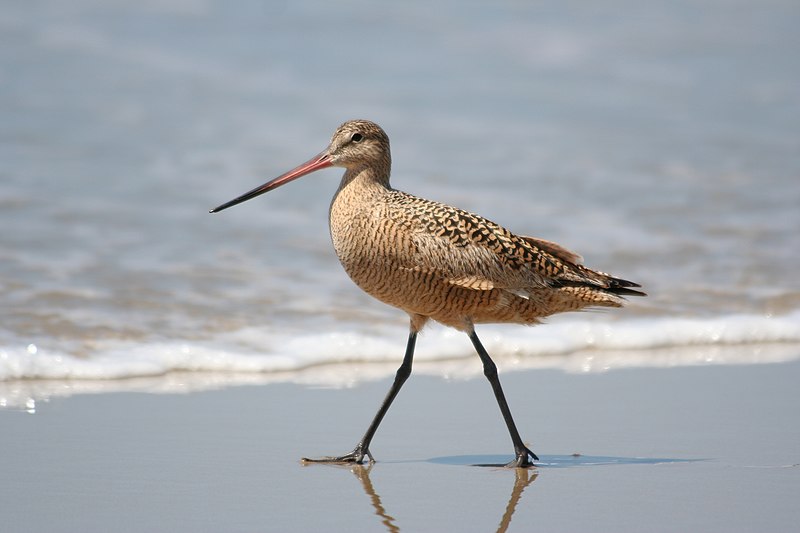
The Marbled Godwit is a large migratory shorebird in the Scolopacidae family and is one of the largest species amongst four godwits.
It was first described by English naturalist George Edwards in 1750, as ‘The Greater American Godwit’.
The bird has long legs and bill for probing mudflats for food. Their plumage varies from mottled gray to reddish or brown on their upperparts, with white underparts that contrast against it.
During breeding season they can be seen along northern prairies in North America and migrate south towards Mexico during winter months.
They are omnivorous feeders but prefer aquatic insects like crustaceans, larvae etc., which makes them an important element of wetland ecosystems across its range.
Scientific classification:
| Kingdom | Animalia |
| Phylum | Chordata |
| Class | Aves |
| Order | Charadriiformes |
| Family | Scolopacidae |
| Genus | Limosa |
| Species | L. fedoa |
Also Featured In: Birds that Live in San Francisco Bay Area, Wetlands Birds You Should Know
47. Reddish Egret
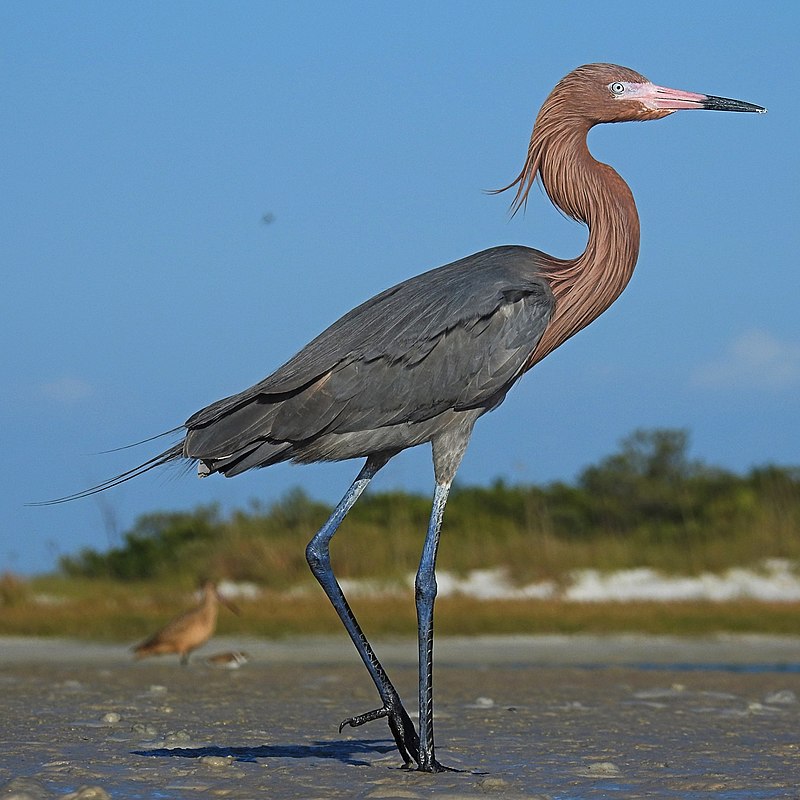
The Reddish Egret is a medium-sized heron that breeds in Central America, The Bahamas, the Caribbean, Texas and Mexico.
It prefers mud flats as its habitat of choice due to its unique foraging behaviour which differs from other herons.
In the past it was hunted widely for its feathers used to make fashionable hats but thankfully this practice has now been stopped.
They have white or grey plumage with pink legs and bill giving them their name.
These birds feed mainly on fish which they catch by making quick darting movements in shallow water or running rapidly through shallows stirring up prey so they can snatch them easily with their bills.
Their long wings enable them to fly quickly when hunting and also during migration season when many travel southwards towards warmer climates.
Scientific classification:
| Kingdom | Animalia |
| Phylum | Chordata |
| Class | Aves |
| Order | Pelecaniformes |
| Family | Ardeidae |
| Genus | Egretta |
| Species | E. rufescens |
Also Featured In: Blue Birds that You’ll Find in Utah, Simmons Island Birds You Should Know
48. Little Blue Heron
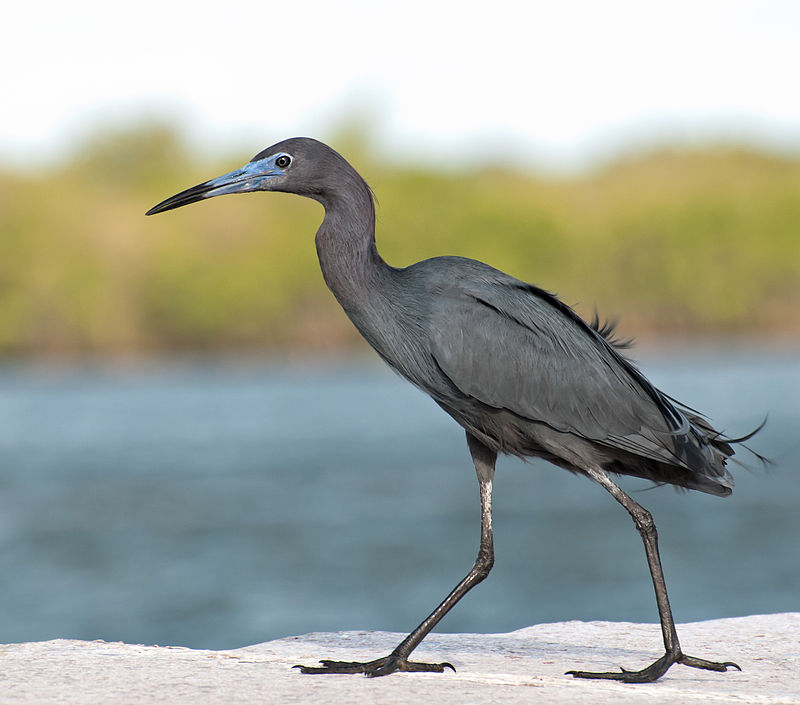
The Little Blue Heron is a small, darkly-colored heron with two-toned bill. Juveniles are completely white, similar to the Snowy Egret. In breeding season, adults develop unique coloration on their head and legs.
The bird has an expansive habitat range that covers much of the Americas from North America all the way down to South America.
They feed mostly in shallow water areas like tidal flats or marshes and eat small aquatic animals such as fish, frogs and crustaceans.
This species can also be found along coastal regions where they gather at night for roosting purposes during winter months when food sources become more scarce due to migration patterns of its prey animals.
These birds have adapted well over time allowing them to persist in most habitats throughout their wide range even despite environmental changes caused by human activities such as pollution or development projects near wetlands ecosystems which are essential for this species’ survival.
Scientific classification:
| Kingdom | Animalia |
| Phylum | Chordata |
| Class | Aves |
| Order | Pelecaniformes |
| Family | Ardeidae |
| Genus | Egretta |
| Species | E. caerulea |
Also Featured In: Blue Birds You’ll Found around Us, Birds that Live around Central Florida